Civil Servants Attitude Assignment PDF
VerifiedAdded on 2021/05/13
|20
|6916
|77
AI Summary
Contribute Materials
Your contribution can guide someone’s learning journey. Share your
documents today.
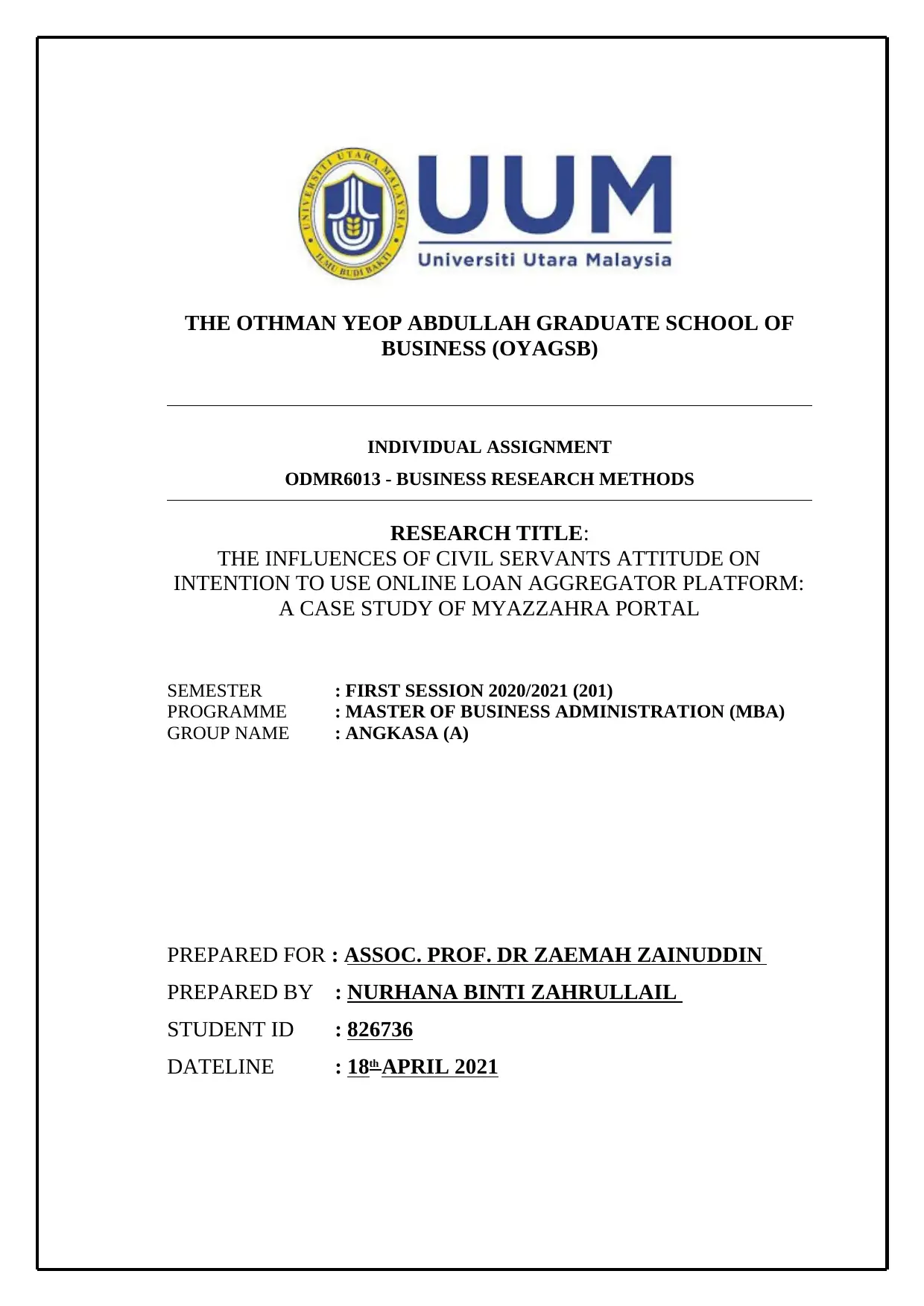
THE OTHMAN YEOP ABDULLAH GRADUATE SCHOOL OF
BUSINESS (OYAGSB)
INDIVIDUAL ASSIGNMENT
ODMR6013 - BUSINESS RESEARCH METHODS
RESEARCH TITLE:
THE INFLUENCES OF CIVIL SERVANTS ATTITUDE ON
INTENTION TO USE ONLINE LOAN AGGREGATOR PLATFORM:
A CASE STUDY OF MYAZZAHRA PORTAL
SEMESTER : FIRST SESSION 2020/2021 (201)
PROGRAMME : MASTER OF BUSINESS ADMINISTRATION (MBA)
GROUP NAME : ANGKASA (A)
PREPARED FOR : ASSOC. PROF. DR ZAEMAH ZAINUDDIN
PREPARED BY : NURHANA BINTI ZAHRULLAIL
STUDENT ID : 826736
DATELINE : 18th APRIL 2021
BUSINESS (OYAGSB)
INDIVIDUAL ASSIGNMENT
ODMR6013 - BUSINESS RESEARCH METHODS
RESEARCH TITLE:
THE INFLUENCES OF CIVIL SERVANTS ATTITUDE ON
INTENTION TO USE ONLINE LOAN AGGREGATOR PLATFORM:
A CASE STUDY OF MYAZZAHRA PORTAL
SEMESTER : FIRST SESSION 2020/2021 (201)
PROGRAMME : MASTER OF BUSINESS ADMINISTRATION (MBA)
GROUP NAME : ANGKASA (A)
PREPARED FOR : ASSOC. PROF. DR ZAEMAH ZAINUDDIN
PREPARED BY : NURHANA BINTI ZAHRULLAIL
STUDENT ID : 826736
DATELINE : 18th APRIL 2021
Secure Best Marks with AI Grader
Need help grading? Try our AI Grader for instant feedback on your assignments.
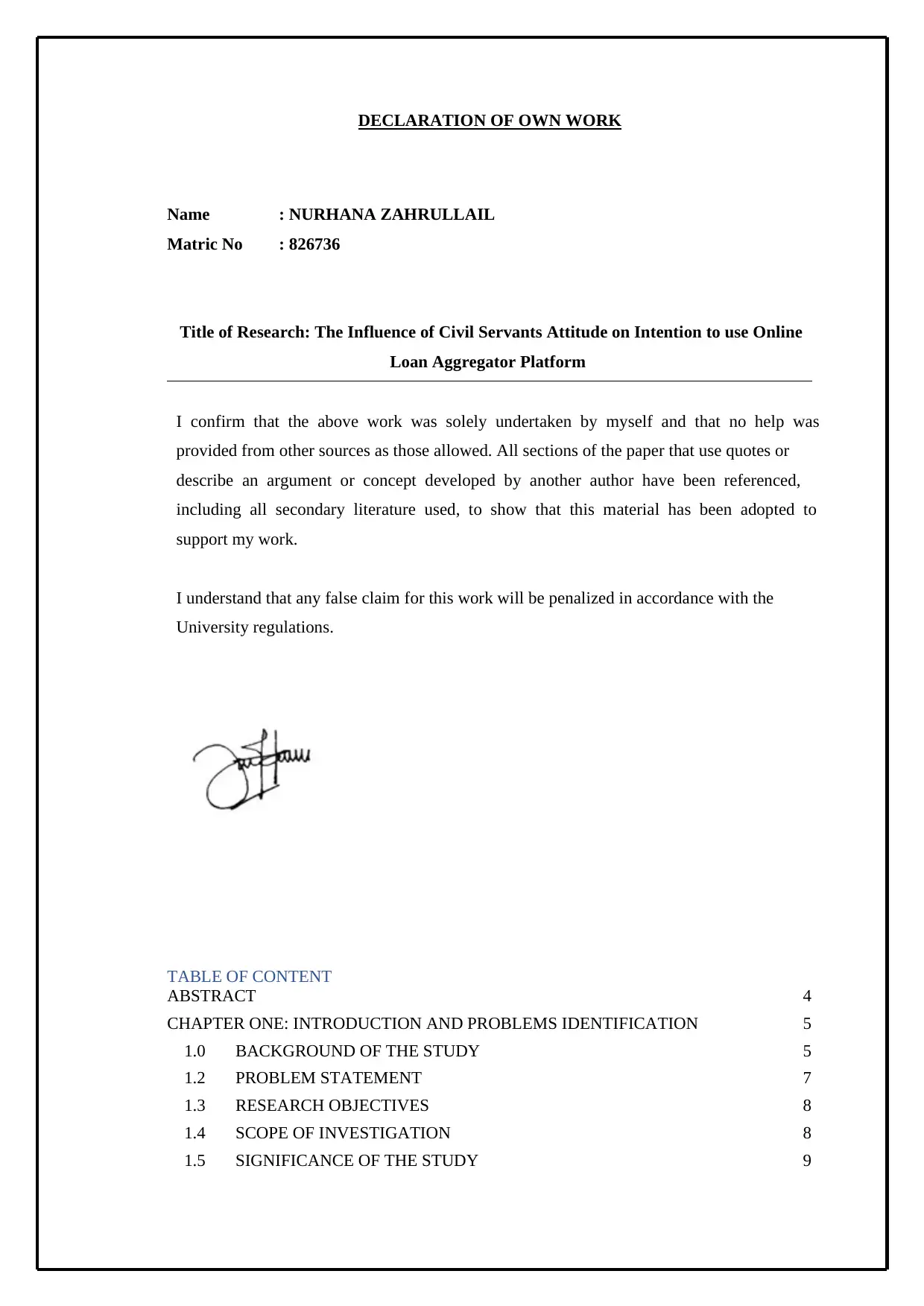
DECLARATION OF OWN WORK
Name : NURHANA ZAHRULLAIL
Matric No : 826736
Title of Research: The Influence of Civil Servants Attitude on Intention to use Online
Loan Aggregator Platform
I confirm that the above work was solely undertaken by myself and that no help was
provided from other sources as those allowed. All sections of the paper that use quotes or
describe an argument or concept developed by another author have been referenced,
including all secondary literature used, to show that this material has been adopted to
support my work.
I understand that any false claim for this work will be penalized in accordance with the
University regulations.
Signature
Date : 4th March 2021
TABLE OF CONTENT
ABSTRACT 4
CHAPTER ONE: INTRODUCTION AND PROBLEMS IDENTIFICATION 5
1.0 BACKGROUND OF THE STUDY 5
1.2 PROBLEM STATEMENT 7
1.3 RESEARCH OBJECTIVES 8
1.4 SCOPE OF INVESTIGATION 8
1.5 SIGNIFICANCE OF THE STUDY 9
Name : NURHANA ZAHRULLAIL
Matric No : 826736
Title of Research: The Influence of Civil Servants Attitude on Intention to use Online
Loan Aggregator Platform
I confirm that the above work was solely undertaken by myself and that no help was
provided from other sources as those allowed. All sections of the paper that use quotes or
describe an argument or concept developed by another author have been referenced,
including all secondary literature used, to show that this material has been adopted to
support my work.
I understand that any false claim for this work will be penalized in accordance with the
University regulations.
Signature
Date : 4th March 2021
TABLE OF CONTENT
ABSTRACT 4
CHAPTER ONE: INTRODUCTION AND PROBLEMS IDENTIFICATION 5
1.0 BACKGROUND OF THE STUDY 5
1.2 PROBLEM STATEMENT 7
1.3 RESEARCH OBJECTIVES 8
1.4 SCOPE OF INVESTIGATION 8
1.5 SIGNIFICANCE OF THE STUDY 9
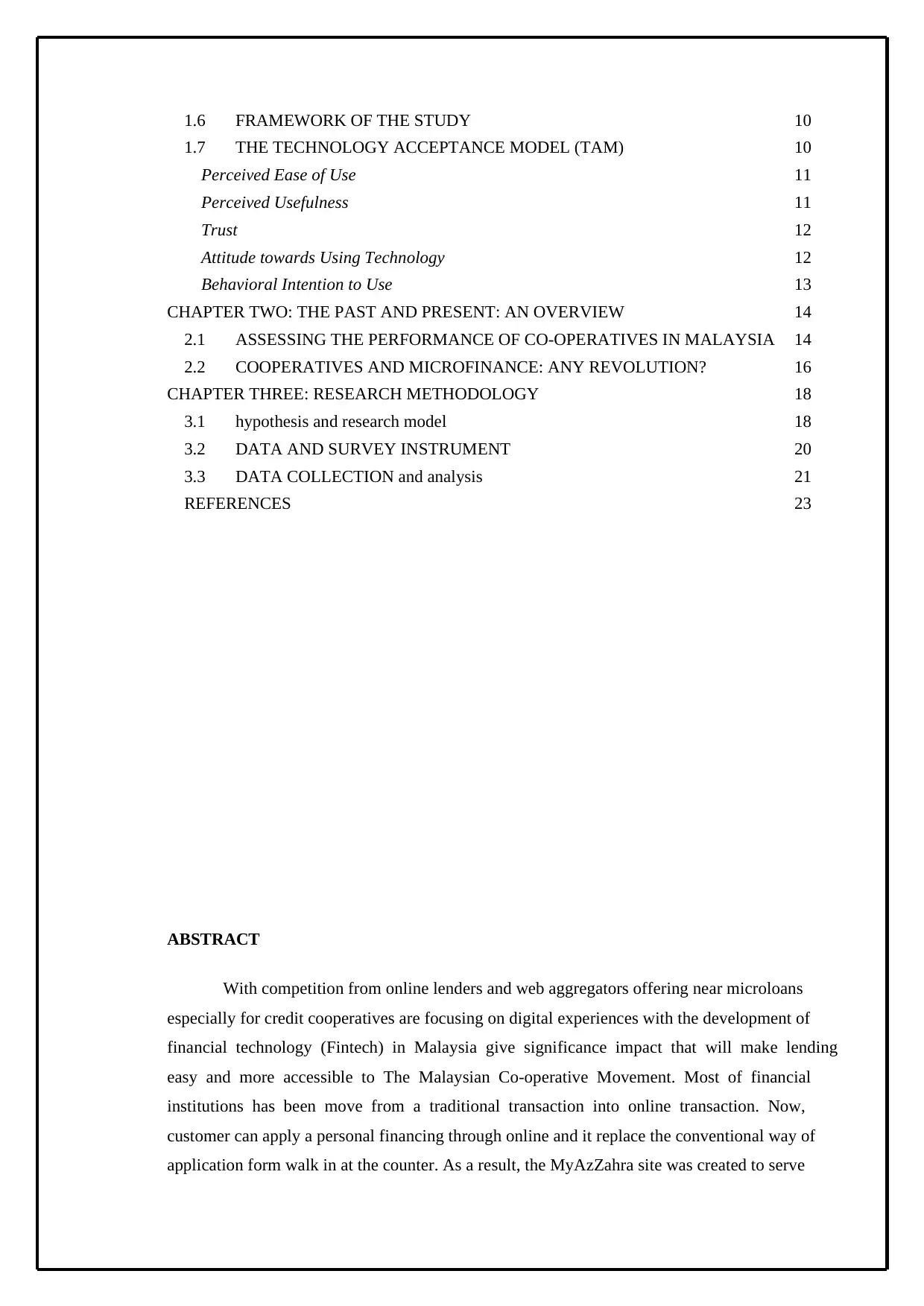
1.6 FRAMEWORK OF THE STUDY 10
1.7 THE TECHNOLOGY ACCEPTANCE MODEL (TAM) 10
Perceived Ease of Use 11
Perceived Usefulness 11
Trust 12
Attitude towards Using Technology 12
Behavioral Intention to Use 13
CHAPTER TWO: THE PAST AND PRESENT: AN OVERVIEW 14
2.1 ASSESSING THE PERFORMANCE OF CO-OPERATIVES IN MALAYSIA 14
2.2 COOPERATIVES AND MICROFINANCE: ANY REVOLUTION? 16
CHAPTER THREE: RESEARCH METHODOLOGY 18
3.1 hypothesis and research model 18
3.2 DATA AND SURVEY INSTRUMENT 20
3.3 DATA COLLECTION and analysis 21
REFERENCES 23
ABSTRACT
With competition from online lenders and web aggregators offering near microloans
especially for credit cooperatives are focusing on digital experiences with the development of
financial technology (Fintech) in Malaysia give significance impact that will make lending
easy and more accessible to The Malaysian Co-operative Movement. Most of financial
institutions has been move from a traditional transaction into online transaction. Now,
customer can apply a personal financing through online and it replace the conventional way of
application form walk in at the counter. As a result, the MyAzZahra site was created to serve
1.7 THE TECHNOLOGY ACCEPTANCE MODEL (TAM) 10
Perceived Ease of Use 11
Perceived Usefulness 11
Trust 12
Attitude towards Using Technology 12
Behavioral Intention to Use 13
CHAPTER TWO: THE PAST AND PRESENT: AN OVERVIEW 14
2.1 ASSESSING THE PERFORMANCE OF CO-OPERATIVES IN MALAYSIA 14
2.2 COOPERATIVES AND MICROFINANCE: ANY REVOLUTION? 16
CHAPTER THREE: RESEARCH METHODOLOGY 18
3.1 hypothesis and research model 18
3.2 DATA AND SURVEY INSTRUMENT 20
3.3 DATA COLLECTION and analysis 21
REFERENCES 23
ABSTRACT
With competition from online lenders and web aggregators offering near microloans
especially for credit cooperatives are focusing on digital experiences with the development of
financial technology (Fintech) in Malaysia give significance impact that will make lending
easy and more accessible to The Malaysian Co-operative Movement. Most of financial
institutions has been move from a traditional transaction into online transaction. Now,
customer can apply a personal financing through online and it replace the conventional way of
application form walk in at the counter. As a result, the MyAzZahra site was created to serve
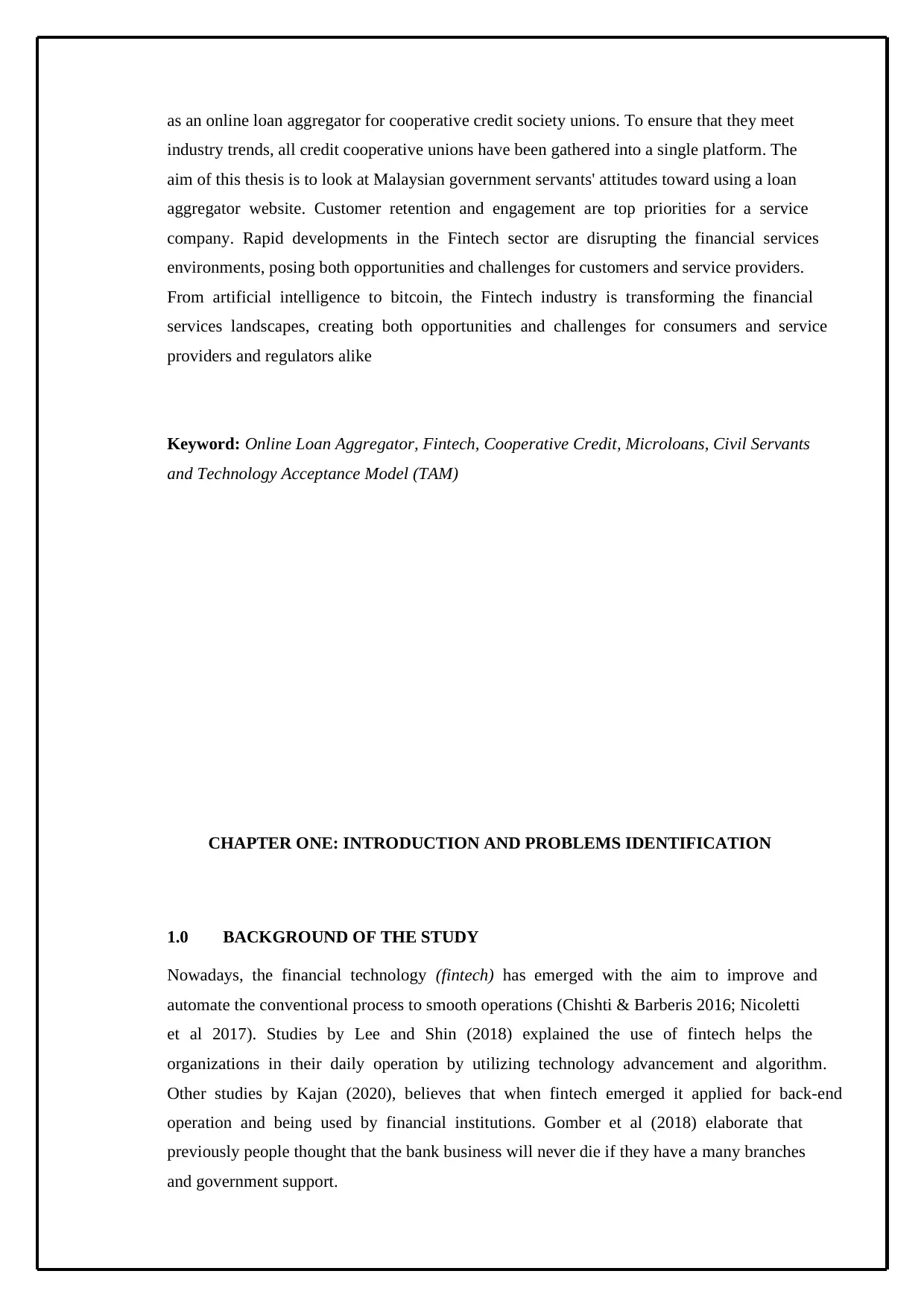
as an online loan aggregator for cooperative credit society unions. To ensure that they meet
industry trends, all credit cooperative unions have been gathered into a single platform. The
aim of this thesis is to look at Malaysian government servants' attitudes toward using a loan
aggregator website. Customer retention and engagement are top priorities for a service
company. Rapid developments in the Fintech sector are disrupting the financial services
environments, posing both opportunities and challenges for customers and service providers.
From artificial intelligence to bitcoin, the Fintech industry is transforming the financial
services landscapes, creating both opportunities and challenges for consumers and service
providers and regulators alike
Keyword: Online Loan Aggregator, Fintech, Cooperative Credit, Microloans, Civil Servants
and Technology Acceptance Model (TAM)
CHAPTER ONE: INTRODUCTION AND PROBLEMS IDENTIFICATION
1.0 BACKGROUND OF THE STUDY
Nowadays, the financial technology (fintech) has emerged with the aim to improve and
automate the conventional process to smooth operations (Chishti & Barberis 2016; Nicoletti
et al 2017). Studies by Lee and Shin (2018) explained the use of fintech helps the
organizations in their daily operation by utilizing technology advancement and algorithm.
Other studies by Kajan (2020), believes that when fintech emerged it applied for back-end
operation and being used by financial institutions. Gomber et al (2018) elaborate that
previously people thought that the bank business will never die if they have a many branches
and government support.
industry trends, all credit cooperative unions have been gathered into a single platform. The
aim of this thesis is to look at Malaysian government servants' attitudes toward using a loan
aggregator website. Customer retention and engagement are top priorities for a service
company. Rapid developments in the Fintech sector are disrupting the financial services
environments, posing both opportunities and challenges for customers and service providers.
From artificial intelligence to bitcoin, the Fintech industry is transforming the financial
services landscapes, creating both opportunities and challenges for consumers and service
providers and regulators alike
Keyword: Online Loan Aggregator, Fintech, Cooperative Credit, Microloans, Civil Servants
and Technology Acceptance Model (TAM)
CHAPTER ONE: INTRODUCTION AND PROBLEMS IDENTIFICATION
1.0 BACKGROUND OF THE STUDY
Nowadays, the financial technology (fintech) has emerged with the aim to improve and
automate the conventional process to smooth operations (Chishti & Barberis 2016; Nicoletti
et al 2017). Studies by Lee and Shin (2018) explained the use of fintech helps the
organizations in their daily operation by utilizing technology advancement and algorithm.
Other studies by Kajan (2020), believes that when fintech emerged it applied for back-end
operation and being used by financial institutions. Gomber et al (2018) elaborate that
previously people thought that the bank business will never die if they have a many branches
and government support.
Secure Best Marks with AI Grader
Need help grading? Try our AI Grader for instant feedback on your assignments.
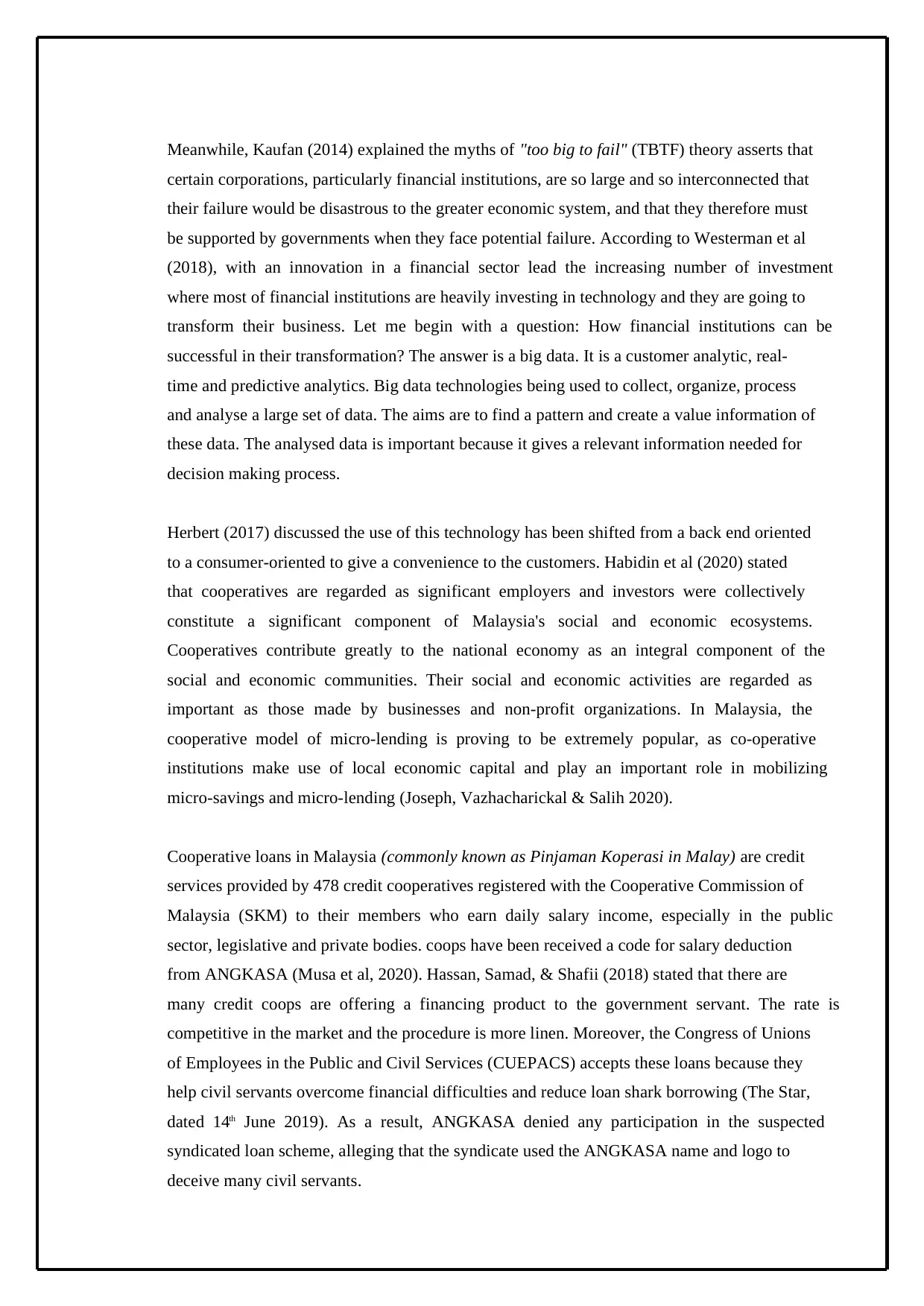
Meanwhile, Kaufan (2014) explained the myths of "too big to fail" (TBTF) theory asserts that
certain corporations, particularly financial institutions, are so large and so interconnected that
their failure would be disastrous to the greater economic system, and that they therefore must
be supported by governments when they face potential failure. According to Westerman et al
(2018), with an innovation in a financial sector lead the increasing number of investment
where most of financial institutions are heavily investing in technology and they are going to
transform their business. Let me begin with a question: How financial institutions can be
successful in their transformation? The answer is a big data. It is a customer analytic, real-
time and predictive analytics. Big data technologies being used to collect, organize, process
and analyse a large set of data. The aims are to find a pattern and create a value information of
these data. The analysed data is important because it gives a relevant information needed for
decision making process.
Herbert (2017) discussed the use of this technology has been shifted from a back end oriented
to a consumer-oriented to give a convenience to the customers. Habidin et al (2020) stated
that cooperatives are regarded as significant employers and investors were collectively
constitute a significant component of Malaysia's social and economic ecosystems.
Cooperatives contribute greatly to the national economy as an integral component of the
social and economic communities. Their social and economic activities are regarded as
important as those made by businesses and non-profit organizations. In Malaysia, the
cooperative model of micro-lending is proving to be extremely popular, as co-operative
institutions make use of local economic capital and play an important role in mobilizing
micro-savings and micro-lending (Joseph, Vazhacharickal & Salih 2020).
Cooperative loans in Malaysia (commonly known as Pinjaman Koperasi in Malay) are credit
services provided by 478 credit cooperatives registered with the Cooperative Commission of
Malaysia (SKM) to their members who earn daily salary income, especially in the public
sector, legislative and private bodies. coops have been received a code for salary deduction
from ANGKASA (Musa et al, 2020). Hassan, Samad, & Shafii (2018) stated that there are
many credit coops are offering a financing product to the government servant. The rate is
competitive in the market and the procedure is more linen. Moreover, the Congress of Unions
of Employees in the Public and Civil Services (CUEPACS) accepts these loans because they
help civil servants overcome financial difficulties and reduce loan shark borrowing (The Star,
dated 14th June 2019). As a result, ANGKASA denied any participation in the suspected
syndicated loan scheme, alleging that the syndicate used the ANGKASA name and logo to
deceive many civil servants.
certain corporations, particularly financial institutions, are so large and so interconnected that
their failure would be disastrous to the greater economic system, and that they therefore must
be supported by governments when they face potential failure. According to Westerman et al
(2018), with an innovation in a financial sector lead the increasing number of investment
where most of financial institutions are heavily investing in technology and they are going to
transform their business. Let me begin with a question: How financial institutions can be
successful in their transformation? The answer is a big data. It is a customer analytic, real-
time and predictive analytics. Big data technologies being used to collect, organize, process
and analyse a large set of data. The aims are to find a pattern and create a value information of
these data. The analysed data is important because it gives a relevant information needed for
decision making process.
Herbert (2017) discussed the use of this technology has been shifted from a back end oriented
to a consumer-oriented to give a convenience to the customers. Habidin et al (2020) stated
that cooperatives are regarded as significant employers and investors were collectively
constitute a significant component of Malaysia's social and economic ecosystems.
Cooperatives contribute greatly to the national economy as an integral component of the
social and economic communities. Their social and economic activities are regarded as
important as those made by businesses and non-profit organizations. In Malaysia, the
cooperative model of micro-lending is proving to be extremely popular, as co-operative
institutions make use of local economic capital and play an important role in mobilizing
micro-savings and micro-lending (Joseph, Vazhacharickal & Salih 2020).
Cooperative loans in Malaysia (commonly known as Pinjaman Koperasi in Malay) are credit
services provided by 478 credit cooperatives registered with the Cooperative Commission of
Malaysia (SKM) to their members who earn daily salary income, especially in the public
sector, legislative and private bodies. coops have been received a code for salary deduction
from ANGKASA (Musa et al, 2020). Hassan, Samad, & Shafii (2018) stated that there are
many credit coops are offering a financing product to the government servant. The rate is
competitive in the market and the procedure is more linen. Moreover, the Congress of Unions
of Employees in the Public and Civil Services (CUEPACS) accepts these loans because they
help civil servants overcome financial difficulties and reduce loan shark borrowing (The Star,
dated 14th June 2019). As a result, ANGKASA denied any participation in the suspected
syndicated loan scheme, alleging that the syndicate used the ANGKASA name and logo to
deceive many civil servants.
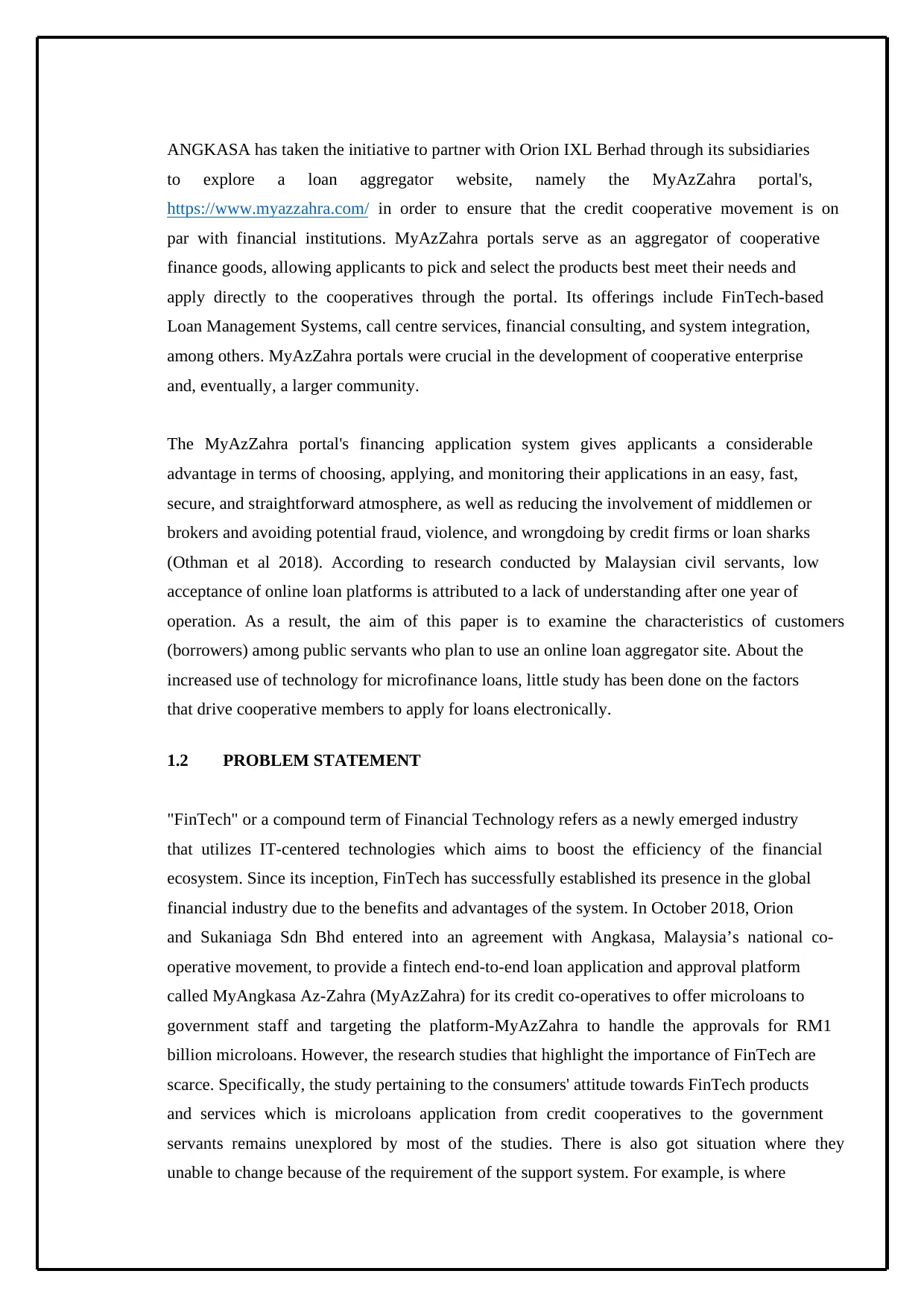
ANGKASA has taken the initiative to partner with Orion IXL Berhad through its subsidiaries
to explore a loan aggregator website, namely the MyAzZahra portal's,
https://www.myazzahra.com/ in order to ensure that the credit cooperative movement is on
par with financial institutions. MyAzZahra portals serve as an aggregator of cooperative
finance goods, allowing applicants to pick and select the products best meet their needs and
apply directly to the cooperatives through the portal. Its offerings include FinTech-based
Loan Management Systems, call centre services, financial consulting, and system integration,
among others. MyAzZahra portals were crucial in the development of cooperative enterprise
and, eventually, a larger community.
The MyAzZahra portal's financing application system gives applicants a considerable
advantage in terms of choosing, applying, and monitoring their applications in an easy, fast,
secure, and straightforward atmosphere, as well as reducing the involvement of middlemen or
brokers and avoiding potential fraud, violence, and wrongdoing by credit firms or loan sharks
(Othman et al 2018). According to research conducted by Malaysian civil servants, low
acceptance of online loan platforms is attributed to a lack of understanding after one year of
operation. As a result, the aim of this paper is to examine the characteristics of customers
(borrowers) among public servants who plan to use an online loan aggregator site. About the
increased use of technology for microfinance loans, little study has been done on the factors
that drive cooperative members to apply for loans electronically.
1.2 PROBLEM STATEMENT
"FinTech" or a compound term of Financial Technology refers as a newly emerged industry
that utilizes IT-centered technologies which aims to boost the efficiency of the financial
ecosystem. Since its inception, FinTech has successfully established its presence in the global
financial industry due to the benefits and advantages of the system. In October 2018, Orion
and Sukaniaga Sdn Bhd entered into an agreement with Angkasa, Malaysia’s national co-
operative movement, to provide a fintech end-to-end loan application and approval platform
called MyAngkasa Az-Zahra (MyAzZahra) for its credit co-operatives to offer microloans to
government staff and targeting the platform-MyAzZahra to handle the approvals for RM1
billion microloans. However, the research studies that highlight the importance of FinTech are
scarce. Specifically, the study pertaining to the consumers' attitude towards FinTech products
and services which is microloans application from credit cooperatives to the government
servants remains unexplored by most of the studies. There is also got situation where they
unable to change because of the requirement of the support system. For example, is where
to explore a loan aggregator website, namely the MyAzZahra portal's,
https://www.myazzahra.com/ in order to ensure that the credit cooperative movement is on
par with financial institutions. MyAzZahra portals serve as an aggregator of cooperative
finance goods, allowing applicants to pick and select the products best meet their needs and
apply directly to the cooperatives through the portal. Its offerings include FinTech-based
Loan Management Systems, call centre services, financial consulting, and system integration,
among others. MyAzZahra portals were crucial in the development of cooperative enterprise
and, eventually, a larger community.
The MyAzZahra portal's financing application system gives applicants a considerable
advantage in terms of choosing, applying, and monitoring their applications in an easy, fast,
secure, and straightforward atmosphere, as well as reducing the involvement of middlemen or
brokers and avoiding potential fraud, violence, and wrongdoing by credit firms or loan sharks
(Othman et al 2018). According to research conducted by Malaysian civil servants, low
acceptance of online loan platforms is attributed to a lack of understanding after one year of
operation. As a result, the aim of this paper is to examine the characteristics of customers
(borrowers) among public servants who plan to use an online loan aggregator site. About the
increased use of technology for microfinance loans, little study has been done on the factors
that drive cooperative members to apply for loans electronically.
1.2 PROBLEM STATEMENT
"FinTech" or a compound term of Financial Technology refers as a newly emerged industry
that utilizes IT-centered technologies which aims to boost the efficiency of the financial
ecosystem. Since its inception, FinTech has successfully established its presence in the global
financial industry due to the benefits and advantages of the system. In October 2018, Orion
and Sukaniaga Sdn Bhd entered into an agreement with Angkasa, Malaysia’s national co-
operative movement, to provide a fintech end-to-end loan application and approval platform
called MyAngkasa Az-Zahra (MyAzZahra) for its credit co-operatives to offer microloans to
government staff and targeting the platform-MyAzZahra to handle the approvals for RM1
billion microloans. However, the research studies that highlight the importance of FinTech are
scarce. Specifically, the study pertaining to the consumers' attitude towards FinTech products
and services which is microloans application from credit cooperatives to the government
servants remains unexplored by most of the studies. There is also got situation where they
unable to change because of the requirement of the support system. For example, is where
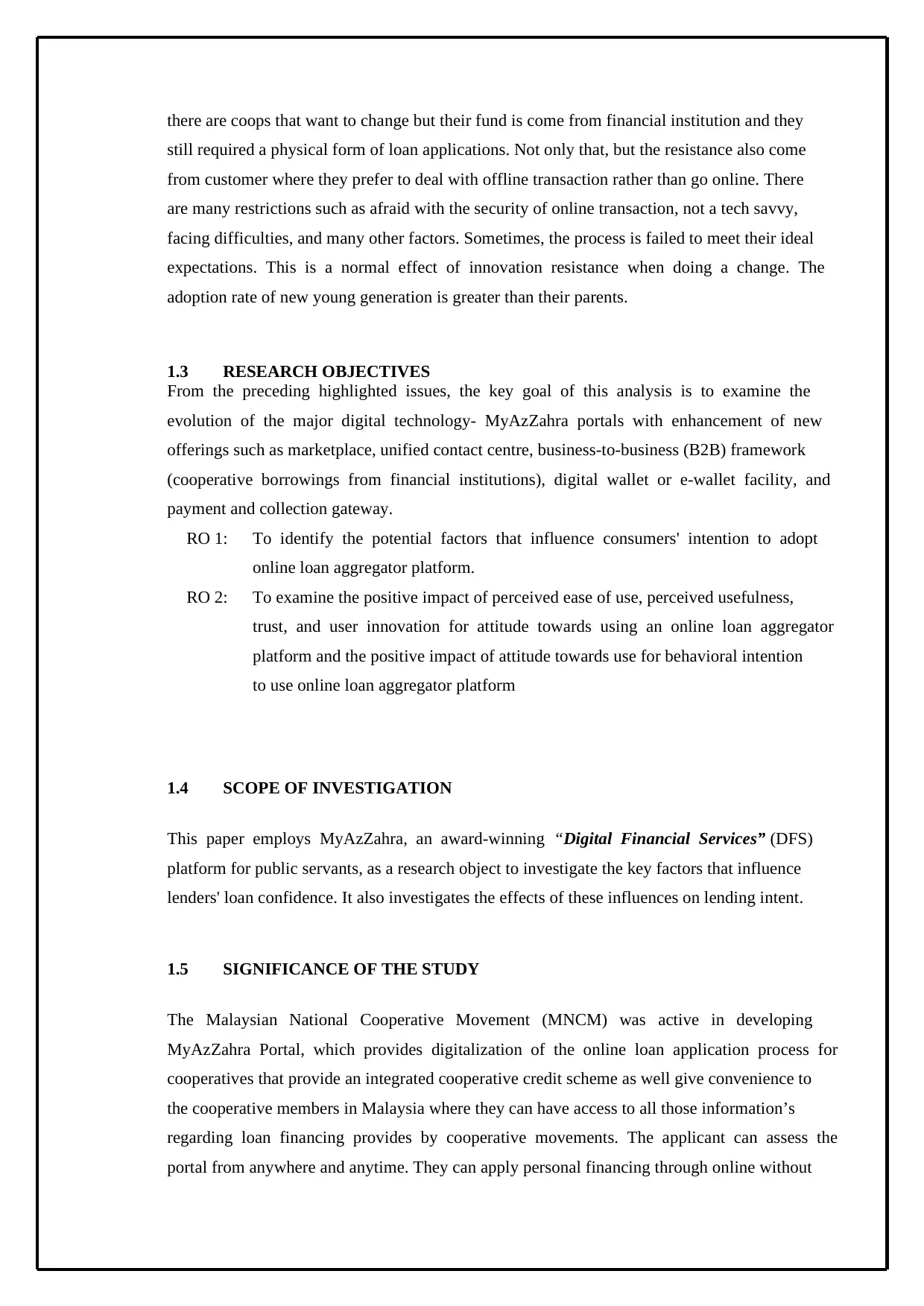
there are coops that want to change but their fund is come from financial institution and they
still required a physical form of loan applications. Not only that, but the resistance also come
from customer where they prefer to deal with offline transaction rather than go online. There
are many restrictions such as afraid with the security of online transaction, not a tech savvy,
facing difficulties, and many other factors. Sometimes, the process is failed to meet their ideal
expectations. This is a normal effect of innovation resistance when doing a change. The
adoption rate of new young generation is greater than their parents.
1.3 RESEARCH OBJECTIVES
From the preceding highlighted issues, the key goal of this analysis is to examine the
evolution of the major digital technology- MyAzZahra portals with enhancement of new
offerings such as marketplace, unified contact centre, business-to-business (B2B) framework
(cooperative borrowings from financial institutions), digital wallet or e-wallet facility, and
payment and collection gateway.
RO 1: To identify the potential factors that influence consumers' intention to adopt
online loan aggregator platform.
RO 2: To examine the positive impact of perceived ease of use, perceived usefulness,
trust, and user innovation for attitude towards using an online loan aggregator
platform and the positive impact of attitude towards use for behavioral intention
to use online loan aggregator platform
1.4 SCOPE OF INVESTIGATION
This paper employs MyAzZahra, an award-winning “Digital Financial Services” (DFS)
platform for public servants, as a research object to investigate the key factors that influence
lenders' loan confidence. It also investigates the effects of these influences on lending intent.
1.5 SIGNIFICANCE OF THE STUDY
The Malaysian National Cooperative Movement (MNCM) was active in developing
MyAzZahra Portal, which provides digitalization of the online loan application process for
cooperatives that provide an integrated cooperative credit scheme as well give convenience to
the cooperative members in Malaysia where they can have access to all those information’s
regarding loan financing provides by cooperative movements. The applicant can assess the
portal from anywhere and anytime. They can apply personal financing through online without
still required a physical form of loan applications. Not only that, but the resistance also come
from customer where they prefer to deal with offline transaction rather than go online. There
are many restrictions such as afraid with the security of online transaction, not a tech savvy,
facing difficulties, and many other factors. Sometimes, the process is failed to meet their ideal
expectations. This is a normal effect of innovation resistance when doing a change. The
adoption rate of new young generation is greater than their parents.
1.3 RESEARCH OBJECTIVES
From the preceding highlighted issues, the key goal of this analysis is to examine the
evolution of the major digital technology- MyAzZahra portals with enhancement of new
offerings such as marketplace, unified contact centre, business-to-business (B2B) framework
(cooperative borrowings from financial institutions), digital wallet or e-wallet facility, and
payment and collection gateway.
RO 1: To identify the potential factors that influence consumers' intention to adopt
online loan aggregator platform.
RO 2: To examine the positive impact of perceived ease of use, perceived usefulness,
trust, and user innovation for attitude towards using an online loan aggregator
platform and the positive impact of attitude towards use for behavioral intention
to use online loan aggregator platform
1.4 SCOPE OF INVESTIGATION
This paper employs MyAzZahra, an award-winning “Digital Financial Services” (DFS)
platform for public servants, as a research object to investigate the key factors that influence
lenders' loan confidence. It also investigates the effects of these influences on lending intent.
1.5 SIGNIFICANCE OF THE STUDY
The Malaysian National Cooperative Movement (MNCM) was active in developing
MyAzZahra Portal, which provides digitalization of the online loan application process for
cooperatives that provide an integrated cooperative credit scheme as well give convenience to
the cooperative members in Malaysia where they can have access to all those information’s
regarding loan financing provides by cooperative movements. The applicant can assess the
portal from anywhere and anytime. They can apply personal financing through online without
Paraphrase This Document
Need a fresh take? Get an instant paraphrase of this document with our AI Paraphraser
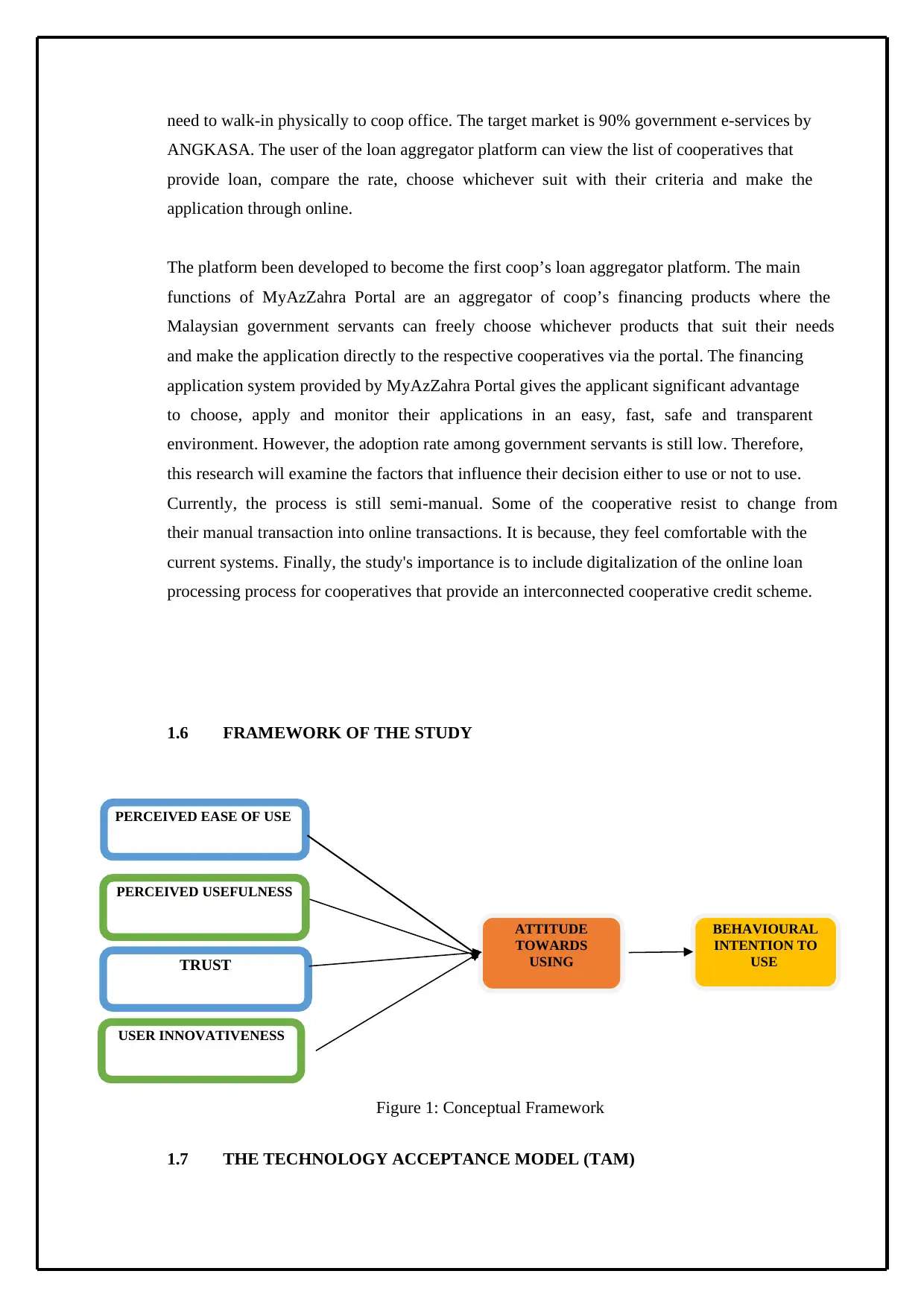
need to walk-in physically to coop office. The target market is 90% government e-services by
ANGKASA. The user of the loan aggregator platform can view the list of cooperatives that
provide loan, compare the rate, choose whichever suit with their criteria and make the
application through online.
The platform been developed to become the first coop’s loan aggregator platform. The main
functions of MyAzZahra Portal are an aggregator of coop’s financing products where the
Malaysian government servants can freely choose whichever products that suit their needs
and make the application directly to the respective cooperatives via the portal. The financing
application system provided by MyAzZahra Portal gives the applicant significant advantage
to choose, apply and monitor their applications in an easy, fast, safe and transparent
environment. However, the adoption rate among government servants is still low. Therefore,
this research will examine the factors that influence their decision either to use or not to use.
Currently, the process is still semi-manual. Some of the cooperative resist to change from
their manual transaction into online transactions. It is because, they feel comfortable with the
current systems. Finally, the study's importance is to include digitalization of the online loan
processing process for cooperatives that provide an interconnected cooperative credit scheme.
1.6 FRAMEWORK OF THE STUDY
Figure 1: Conceptual Framework
1.7 THE TECHNOLOGY ACCEPTANCE MODEL (TAM)
PERCEIVED EASE OF USE
PERCEIVED USEFULNESS
BEHAVIOURAL
INTENTION TO
USE
ATTITUDE
TOWARDS
USINGTRUST
USER INNOVATIVENESS
ANGKASA. The user of the loan aggregator platform can view the list of cooperatives that
provide loan, compare the rate, choose whichever suit with their criteria and make the
application through online.
The platform been developed to become the first coop’s loan aggregator platform. The main
functions of MyAzZahra Portal are an aggregator of coop’s financing products where the
Malaysian government servants can freely choose whichever products that suit their needs
and make the application directly to the respective cooperatives via the portal. The financing
application system provided by MyAzZahra Portal gives the applicant significant advantage
to choose, apply and monitor their applications in an easy, fast, safe and transparent
environment. However, the adoption rate among government servants is still low. Therefore,
this research will examine the factors that influence their decision either to use or not to use.
Currently, the process is still semi-manual. Some of the cooperative resist to change from
their manual transaction into online transactions. It is because, they feel comfortable with the
current systems. Finally, the study's importance is to include digitalization of the online loan
processing process for cooperatives that provide an interconnected cooperative credit scheme.
1.6 FRAMEWORK OF THE STUDY
Figure 1: Conceptual Framework
1.7 THE TECHNOLOGY ACCEPTANCE MODEL (TAM)
PERCEIVED EASE OF USE
PERCEIVED USEFULNESS
BEHAVIOURAL
INTENTION TO
USE
ATTITUDE
TOWARDS
USINGTRUST
USER INNOVATIVENESS
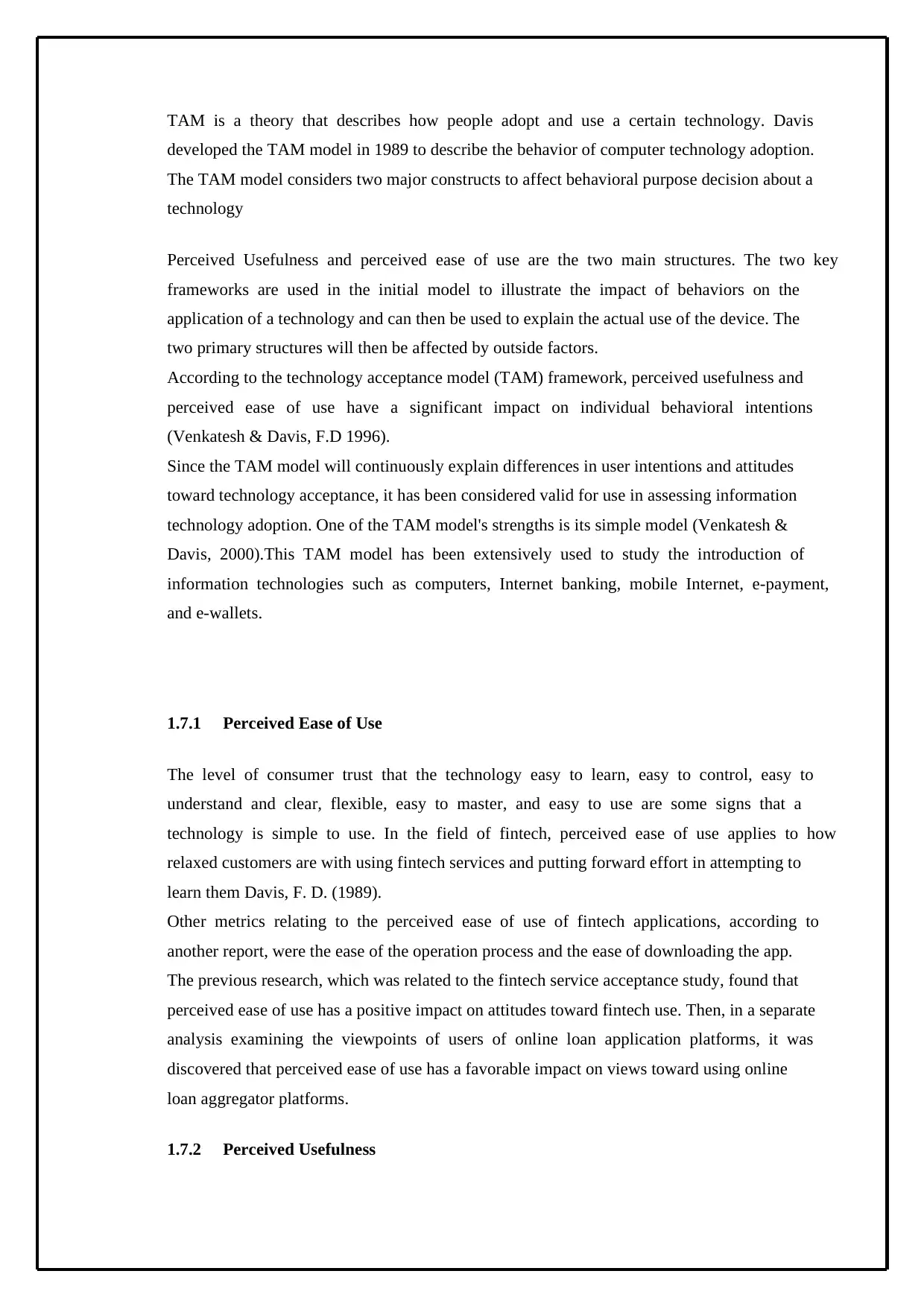
TAM is a theory that describes how people adopt and use a certain technology. Davis
developed the TAM model in 1989 to describe the behavior of computer technology adoption.
The TAM model considers two major constructs to affect behavioral purpose decision about a
technology
Perceived Usefulness and perceived ease of use are the two main structures. The two key
frameworks are used in the initial model to illustrate the impact of behaviors on the
application of a technology and can then be used to explain the actual use of the device. The
two primary structures will then be affected by outside factors.
According to the technology acceptance model (TAM) framework, perceived usefulness and
perceived ease of use have a significant impact on individual behavioral intentions
(Venkatesh & Davis, F.D 1996).
Since the TAM model will continuously explain differences in user intentions and attitudes
toward technology acceptance, it has been considered valid for use in assessing information
technology adoption. One of the TAM model's strengths is its simple model (Venkatesh &
Davis, 2000).This TAM model has been extensively used to study the introduction of
information technologies such as computers, Internet banking, mobile Internet, e-payment,
and e-wallets.
1.7.1 Perceived Ease of Use
The level of consumer trust that the technology easy to learn, easy to control, easy to
understand and clear, flexible, easy to master, and easy to use are some signs that a
technology is simple to use. In the field of fintech, perceived ease of use applies to how
relaxed customers are with using fintech services and putting forward effort in attempting to
learn them Davis, F. D. (1989).
Other metrics relating to the perceived ease of use of fintech applications, according to
another report, were the ease of the operation process and the ease of downloading the app.
The previous research, which was related to the fintech service acceptance study, found that
perceived ease of use has a positive impact on attitudes toward fintech use. Then, in a separate
analysis examining the viewpoints of users of online loan application platforms, it was
discovered that perceived ease of use has a favorable impact on views toward using online
loan aggregator platforms.
1.7.2 Perceived Usefulness
developed the TAM model in 1989 to describe the behavior of computer technology adoption.
The TAM model considers two major constructs to affect behavioral purpose decision about a
technology
Perceived Usefulness and perceived ease of use are the two main structures. The two key
frameworks are used in the initial model to illustrate the impact of behaviors on the
application of a technology and can then be used to explain the actual use of the device. The
two primary structures will then be affected by outside factors.
According to the technology acceptance model (TAM) framework, perceived usefulness and
perceived ease of use have a significant impact on individual behavioral intentions
(Venkatesh & Davis, F.D 1996).
Since the TAM model will continuously explain differences in user intentions and attitudes
toward technology acceptance, it has been considered valid for use in assessing information
technology adoption. One of the TAM model's strengths is its simple model (Venkatesh &
Davis, 2000).This TAM model has been extensively used to study the introduction of
information technologies such as computers, Internet banking, mobile Internet, e-payment,
and e-wallets.
1.7.1 Perceived Ease of Use
The level of consumer trust that the technology easy to learn, easy to control, easy to
understand and clear, flexible, easy to master, and easy to use are some signs that a
technology is simple to use. In the field of fintech, perceived ease of use applies to how
relaxed customers are with using fintech services and putting forward effort in attempting to
learn them Davis, F. D. (1989).
Other metrics relating to the perceived ease of use of fintech applications, according to
another report, were the ease of the operation process and the ease of downloading the app.
The previous research, which was related to the fintech service acceptance study, found that
perceived ease of use has a positive impact on attitudes toward fintech use. Then, in a separate
analysis examining the viewpoints of users of online loan application platforms, it was
discovered that perceived ease of use has a favorable impact on views toward using online
loan aggregator platforms.
1.7.2 Perceived Usefulness
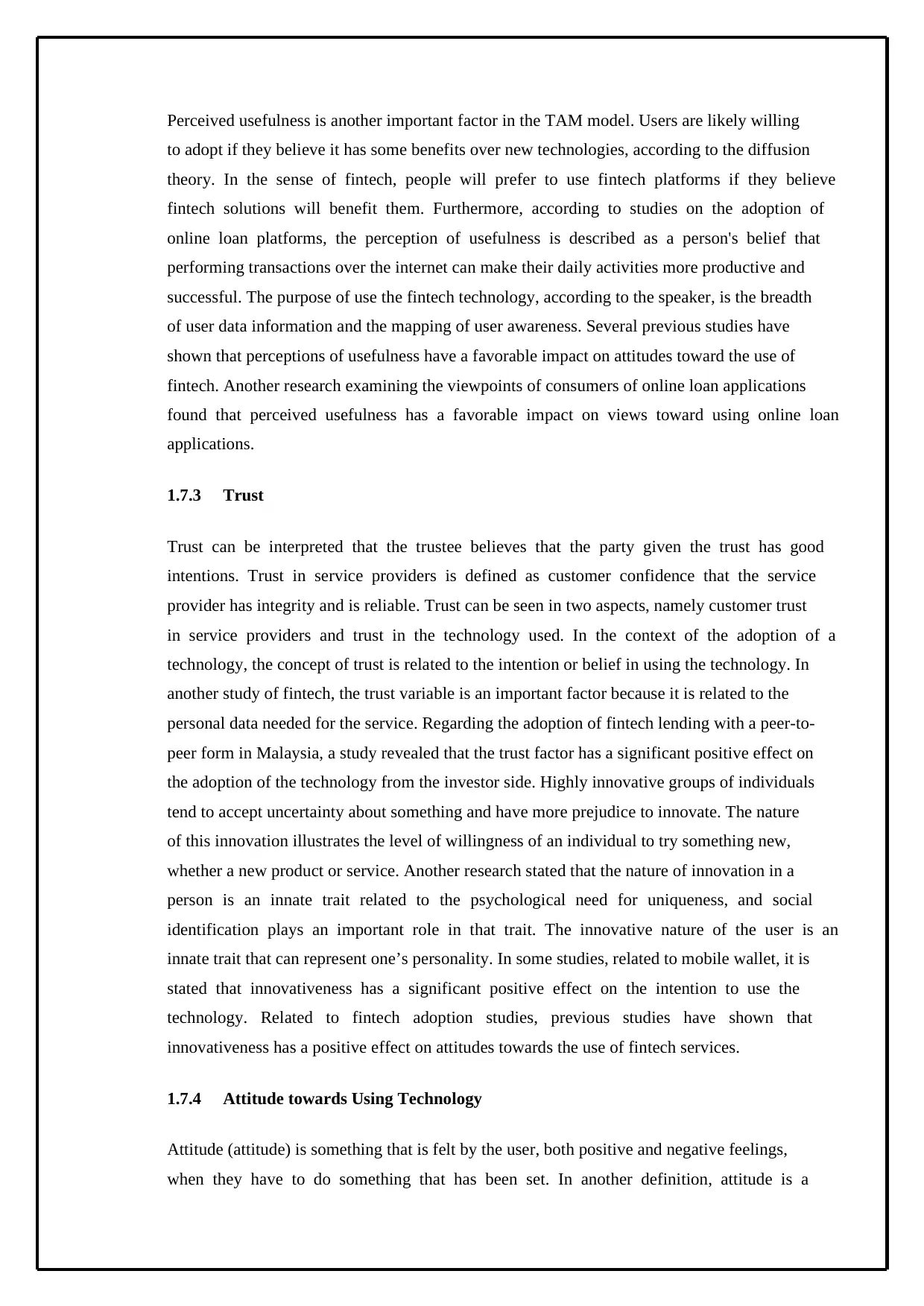
Perceived usefulness is another important factor in the TAM model. Users are likely willing
to adopt if they believe it has some benefits over new technologies, according to the diffusion
theory. In the sense of fintech, people will prefer to use fintech platforms if they believe
fintech solutions will benefit them. Furthermore, according to studies on the adoption of
online loan platforms, the perception of usefulness is described as a person's belief that
performing transactions over the internet can make their daily activities more productive and
successful. The purpose of use the fintech technology, according to the speaker, is the breadth
of user data information and the mapping of user awareness. Several previous studies have
shown that perceptions of usefulness have a favorable impact on attitudes toward the use of
fintech. Another research examining the viewpoints of consumers of online loan applications
found that perceived usefulness has a favorable impact on views toward using online loan
applications.
1.7.3 Trust
Trust can be interpreted that the trustee believes that the party given the trust has good
intentions. Trust in service providers is defined as customer confidence that the service
provider has integrity and is reliable. Trust can be seen in two aspects, namely customer trust
in service providers and trust in the technology used. In the context of the adoption of a
technology, the concept of trust is related to the intention or belief in using the technology. In
another study of fintech, the trust variable is an important factor because it is related to the
personal data needed for the service. Regarding the adoption of fintech lending with a peer-to-
peer form in Malaysia, a study revealed that the trust factor has a significant positive effect on
the adoption of the technology from the investor side. Highly innovative groups of individuals
tend to accept uncertainty about something and have more prejudice to innovate. The nature
of this innovation illustrates the level of willingness of an individual to try something new,
whether a new product or service. Another research stated that the nature of innovation in a
person is an innate trait related to the psychological need for uniqueness, and social
identification plays an important role in that trait. The innovative nature of the user is an
innate trait that can represent one’s personality. In some studies, related to mobile wallet, it is
stated that innovativeness has a significant positive effect on the intention to use the
technology. Related to fintech adoption studies, previous studies have shown that
innovativeness has a positive effect on attitudes towards the use of fintech services.
1.7.4 Attitude towards Using Technology
Attitude (attitude) is something that is felt by the user, both positive and negative feelings,
when they have to do something that has been set. In another definition, attitude is a
to adopt if they believe it has some benefits over new technologies, according to the diffusion
theory. In the sense of fintech, people will prefer to use fintech platforms if they believe
fintech solutions will benefit them. Furthermore, according to studies on the adoption of
online loan platforms, the perception of usefulness is described as a person's belief that
performing transactions over the internet can make their daily activities more productive and
successful. The purpose of use the fintech technology, according to the speaker, is the breadth
of user data information and the mapping of user awareness. Several previous studies have
shown that perceptions of usefulness have a favorable impact on attitudes toward the use of
fintech. Another research examining the viewpoints of consumers of online loan applications
found that perceived usefulness has a favorable impact on views toward using online loan
applications.
1.7.3 Trust
Trust can be interpreted that the trustee believes that the party given the trust has good
intentions. Trust in service providers is defined as customer confidence that the service
provider has integrity and is reliable. Trust can be seen in two aspects, namely customer trust
in service providers and trust in the technology used. In the context of the adoption of a
technology, the concept of trust is related to the intention or belief in using the technology. In
another study of fintech, the trust variable is an important factor because it is related to the
personal data needed for the service. Regarding the adoption of fintech lending with a peer-to-
peer form in Malaysia, a study revealed that the trust factor has a significant positive effect on
the adoption of the technology from the investor side. Highly innovative groups of individuals
tend to accept uncertainty about something and have more prejudice to innovate. The nature
of this innovation illustrates the level of willingness of an individual to try something new,
whether a new product or service. Another research stated that the nature of innovation in a
person is an innate trait related to the psychological need for uniqueness, and social
identification plays an important role in that trait. The innovative nature of the user is an
innate trait that can represent one’s personality. In some studies, related to mobile wallet, it is
stated that innovativeness has a significant positive effect on the intention to use the
technology. Related to fintech adoption studies, previous studies have shown that
innovativeness has a positive effect on attitudes towards the use of fintech services.
1.7.4 Attitude towards Using Technology
Attitude (attitude) is something that is felt by the user, both positive and negative feelings,
when they have to do something that has been set. In another definition, attitude is a
Secure Best Marks with AI Grader
Need help grading? Try our AI Grader for instant feedback on your assignments.
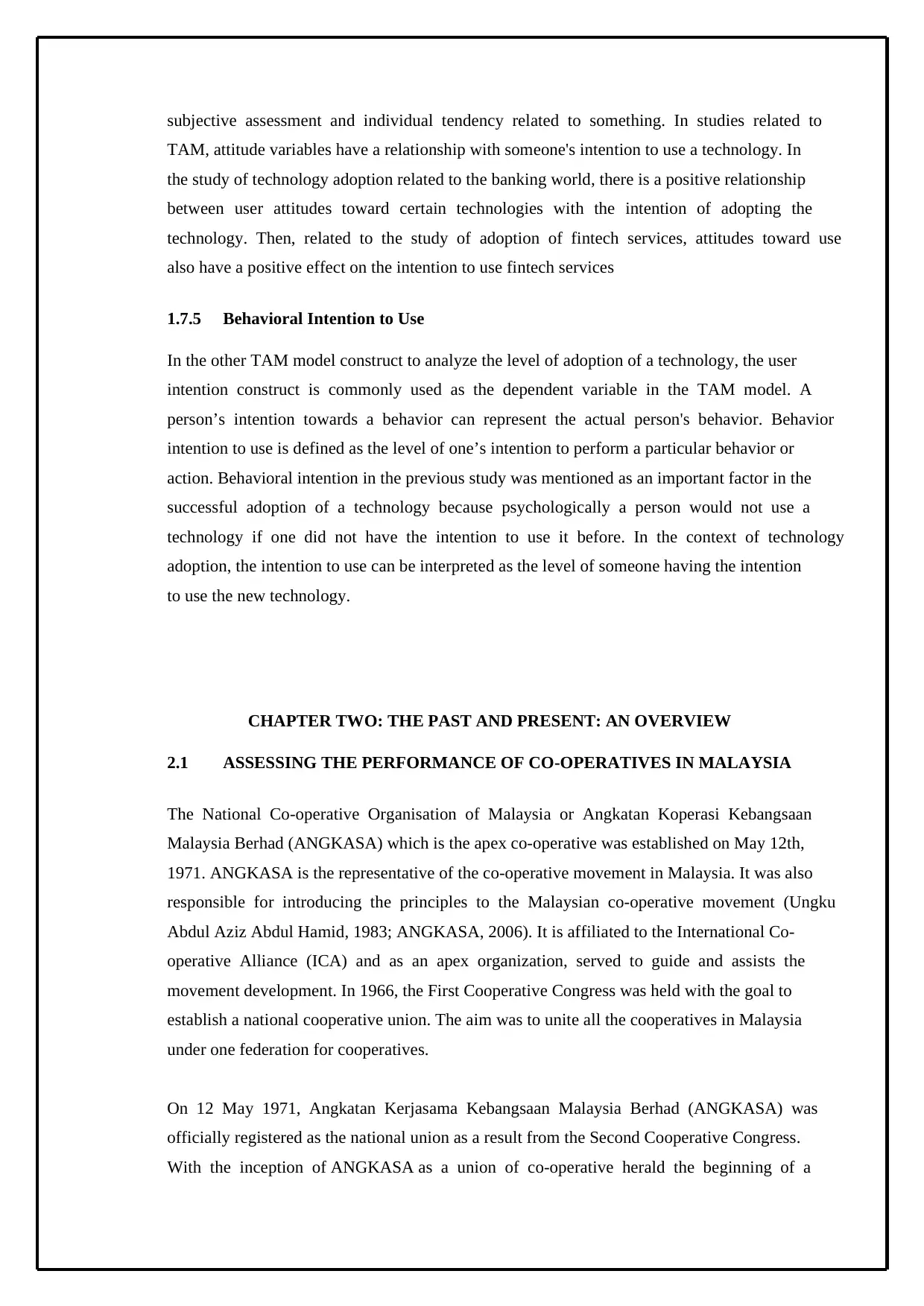
subjective assessment and individual tendency related to something. In studies related to
TAM, attitude variables have a relationship with someone's intention to use a technology. In
the study of technology adoption related to the banking world, there is a positive relationship
between user attitudes toward certain technologies with the intention of adopting the
technology. Then, related to the study of adoption of fintech services, attitudes toward use
also have a positive effect on the intention to use fintech services
1.7.5 Behavioral Intention to Use
In the other TAM model construct to analyze the level of adoption of a technology, the user
intention construct is commonly used as the dependent variable in the TAM model. A
person’s intention towards a behavior can represent the actual person's behavior. Behavior
intention to use is defined as the level of one’s intention to perform a particular behavior or
action. Behavioral intention in the previous study was mentioned as an important factor in the
successful adoption of a technology because psychologically a person would not use a
technology if one did not have the intention to use it before. In the context of technology
adoption, the intention to use can be interpreted as the level of someone having the intention
to use the new technology.
CHAPTER TWO: THE PAST AND PRESENT: AN OVERVIEW
2.1 ASSESSING THE PERFORMANCE OF CO-OPERATIVES IN MALAYSIA
The National Co-operative Organisation of Malaysia or Angkatan Koperasi Kebangsaan
Malaysia Berhad (ANGKASA) which is the apex co-operative was established on May 12th,
1971. ANGKASA is the representative of the co-operative movement in Malaysia. It was also
responsible for introducing the principles to the Malaysian co-operative movement (Ungku
Abdul Aziz Abdul Hamid, 1983; ANGKASA, 2006). It is affiliated to the International Co-
operative Alliance (ICA) and as an apex organization, served to guide and assists the
movement development. In 1966, the First Cooperative Congress was held with the goal to
establish a national cooperative union. The aim was to unite all the cooperatives in Malaysia
under one federation for cooperatives.
On 12 May 1971, Angkatan Kerjasama Kebangsaan Malaysia Berhad (ANGKASA) was
officially registered as the national union as a result from the Second Cooperative Congress.
With the inception of ANGKASA as a union of co-operative herald the beginning of a
TAM, attitude variables have a relationship with someone's intention to use a technology. In
the study of technology adoption related to the banking world, there is a positive relationship
between user attitudes toward certain technologies with the intention of adopting the
technology. Then, related to the study of adoption of fintech services, attitudes toward use
also have a positive effect on the intention to use fintech services
1.7.5 Behavioral Intention to Use
In the other TAM model construct to analyze the level of adoption of a technology, the user
intention construct is commonly used as the dependent variable in the TAM model. A
person’s intention towards a behavior can represent the actual person's behavior. Behavior
intention to use is defined as the level of one’s intention to perform a particular behavior or
action. Behavioral intention in the previous study was mentioned as an important factor in the
successful adoption of a technology because psychologically a person would not use a
technology if one did not have the intention to use it before. In the context of technology
adoption, the intention to use can be interpreted as the level of someone having the intention
to use the new technology.
CHAPTER TWO: THE PAST AND PRESENT: AN OVERVIEW
2.1 ASSESSING THE PERFORMANCE OF CO-OPERATIVES IN MALAYSIA
The National Co-operative Organisation of Malaysia or Angkatan Koperasi Kebangsaan
Malaysia Berhad (ANGKASA) which is the apex co-operative was established on May 12th,
1971. ANGKASA is the representative of the co-operative movement in Malaysia. It was also
responsible for introducing the principles to the Malaysian co-operative movement (Ungku
Abdul Aziz Abdul Hamid, 1983; ANGKASA, 2006). It is affiliated to the International Co-
operative Alliance (ICA) and as an apex organization, served to guide and assists the
movement development. In 1966, the First Cooperative Congress was held with the goal to
establish a national cooperative union. The aim was to unite all the cooperatives in Malaysia
under one federation for cooperatives.
On 12 May 1971, Angkatan Kerjasama Kebangsaan Malaysia Berhad (ANGKASA) was
officially registered as the national union as a result from the Second Cooperative Congress.
With the inception of ANGKASA as a union of co-operative herald the beginning of a
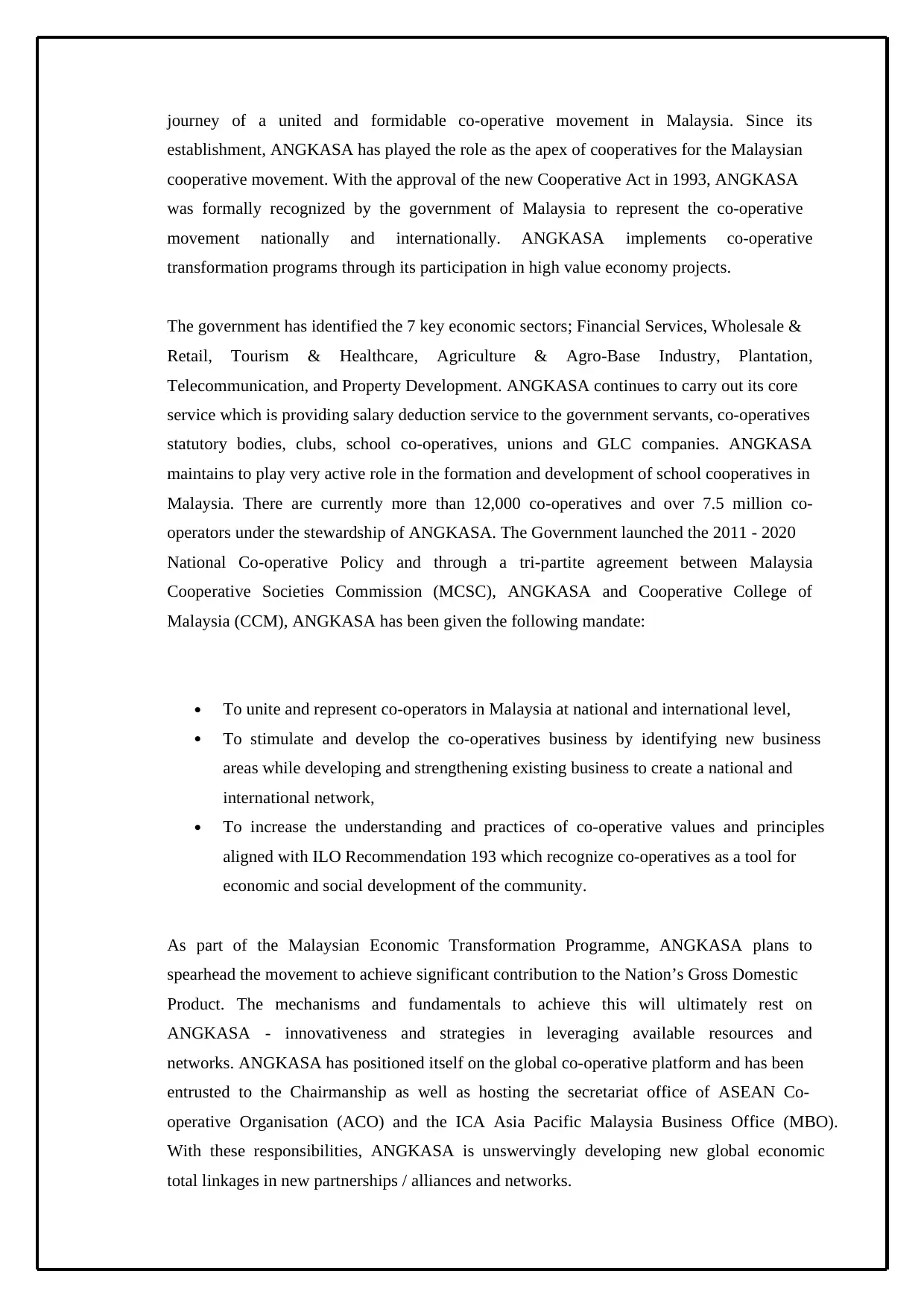
journey of a united and formidable co-operative movement in Malaysia. Since its
establishment, ANGKASA has played the role as the apex of cooperatives for the Malaysian
cooperative movement. With the approval of the new Cooperative Act in 1993, ANGKASA
was formally recognized by the government of Malaysia to represent the co-operative
movement nationally and internationally. ANGKASA implements co-operative
transformation programs through its participation in high value economy projects.
The government has identified the 7 key economic sectors; Financial Services, Wholesale &
Retail, Tourism & Healthcare, Agriculture & Agro-Base Industry, Plantation,
Telecommunication, and Property Development. ANGKASA continues to carry out its core
service which is providing salary deduction service to the government servants, co-operatives
statutory bodies, clubs, school co-operatives, unions and GLC companies. ANGKASA
maintains to play very active role in the formation and development of school cooperatives in
Malaysia. There are currently more than 12,000 co-operatives and over 7.5 million co-
operators under the stewardship of ANGKASA. The Government launched the 2011 - 2020
National Co-operative Policy and through a tri-partite agreement between Malaysia
Cooperative Societies Commission (MCSC), ANGKASA and Cooperative College of
Malaysia (CCM), ANGKASA has been given the following mandate:
To unite and represent co-operators in Malaysia at national and international level,
To stimulate and develop the co-operatives business by identifying new business
areas while developing and strengthening existing business to create a national and
international network,
To increase the understanding and practices of co-operative values and principles
aligned with ILO Recommendation 193 which recognize co-operatives as a tool for
economic and social development of the community.
As part of the Malaysian Economic Transformation Programme, ANGKASA plans to
spearhead the movement to achieve significant contribution to the Nation’s Gross Domestic
Product. The mechanisms and fundamentals to achieve this will ultimately rest on
ANGKASA - innovativeness and strategies in leveraging available resources and
networks. ANGKASA has positioned itself on the global co-operative platform and has been
entrusted to the Chairmanship as well as hosting the secretariat office of ASEAN Co-
operative Organisation (ACO) and the ICA Asia Pacific Malaysia Business Office (MBO).
With these responsibilities, ANGKASA is unswervingly developing new global economic
total linkages in new partnerships / alliances and networks.
establishment, ANGKASA has played the role as the apex of cooperatives for the Malaysian
cooperative movement. With the approval of the new Cooperative Act in 1993, ANGKASA
was formally recognized by the government of Malaysia to represent the co-operative
movement nationally and internationally. ANGKASA implements co-operative
transformation programs through its participation in high value economy projects.
The government has identified the 7 key economic sectors; Financial Services, Wholesale &
Retail, Tourism & Healthcare, Agriculture & Agro-Base Industry, Plantation,
Telecommunication, and Property Development. ANGKASA continues to carry out its core
service which is providing salary deduction service to the government servants, co-operatives
statutory bodies, clubs, school co-operatives, unions and GLC companies. ANGKASA
maintains to play very active role in the formation and development of school cooperatives in
Malaysia. There are currently more than 12,000 co-operatives and over 7.5 million co-
operators under the stewardship of ANGKASA. The Government launched the 2011 - 2020
National Co-operative Policy and through a tri-partite agreement between Malaysia
Cooperative Societies Commission (MCSC), ANGKASA and Cooperative College of
Malaysia (CCM), ANGKASA has been given the following mandate:
To unite and represent co-operators in Malaysia at national and international level,
To stimulate and develop the co-operatives business by identifying new business
areas while developing and strengthening existing business to create a national and
international network,
To increase the understanding and practices of co-operative values and principles
aligned with ILO Recommendation 193 which recognize co-operatives as a tool for
economic and social development of the community.
As part of the Malaysian Economic Transformation Programme, ANGKASA plans to
spearhead the movement to achieve significant contribution to the Nation’s Gross Domestic
Product. The mechanisms and fundamentals to achieve this will ultimately rest on
ANGKASA - innovativeness and strategies in leveraging available resources and
networks. ANGKASA has positioned itself on the global co-operative platform and has been
entrusted to the Chairmanship as well as hosting the secretariat office of ASEAN Co-
operative Organisation (ACO) and the ICA Asia Pacific Malaysia Business Office (MBO).
With these responsibilities, ANGKASA is unswervingly developing new global economic
total linkages in new partnerships / alliances and networks.
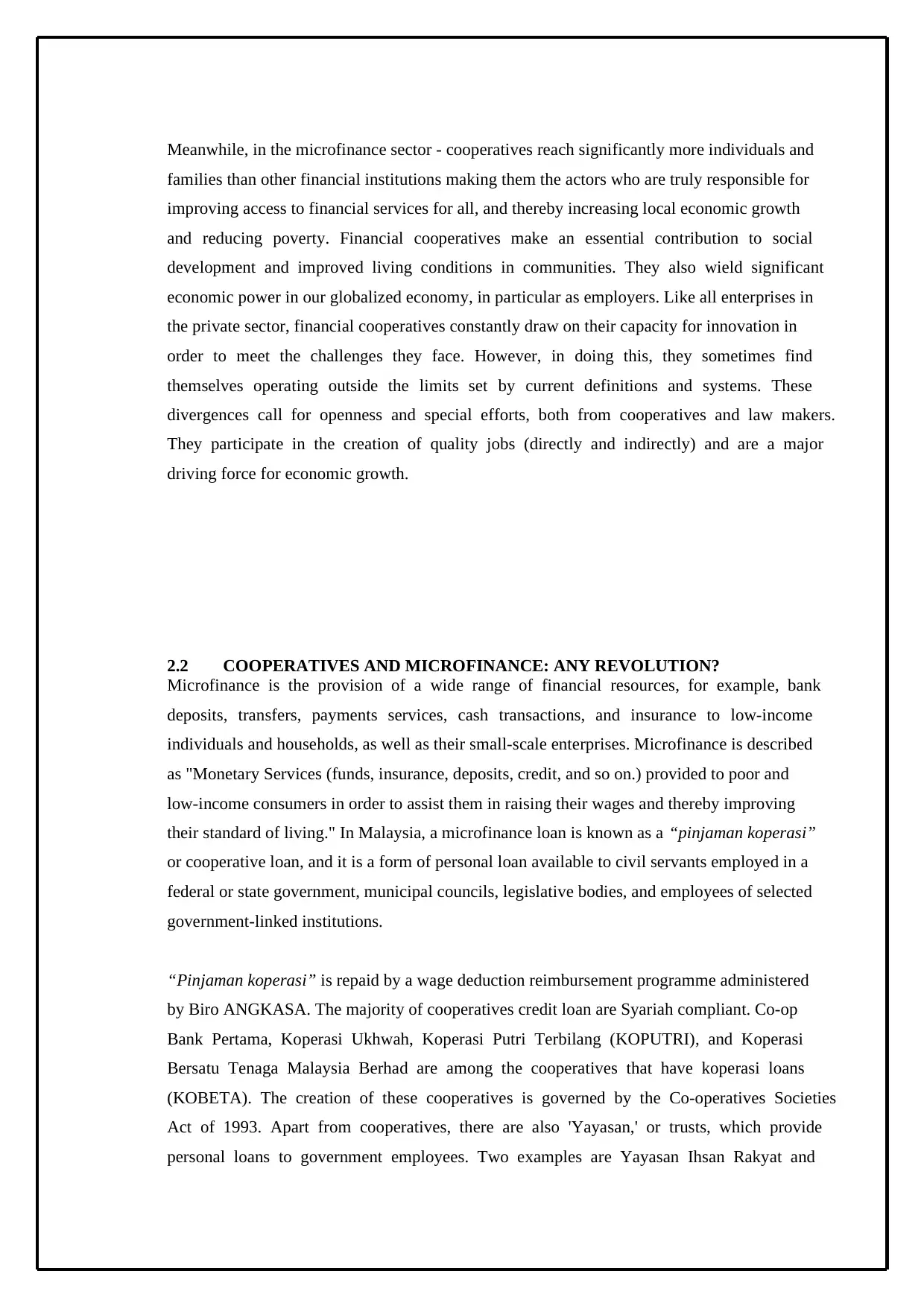
Meanwhile, in the microfinance sector - cooperatives reach significantly more individuals and
families than other financial institutions making them the actors who are truly responsible for
improving access to financial services for all, and thereby increasing local economic growth
and reducing poverty. Financial cooperatives make an essential contribution to social
development and improved living conditions in communities. They also wield significant
economic power in our globalized economy, in particular as employers. Like all enterprises in
the private sector, financial cooperatives constantly draw on their capacity for innovation in
order to meet the challenges they face. However, in doing this, they sometimes find
themselves operating outside the limits set by current definitions and systems. These
divergences call for openness and special efforts, both from cooperatives and law makers.
They participate in the creation of quality jobs (directly and indirectly) and are a major
driving force for economic growth.
2.2 COOPERATIVES AND MICROFINANCE: ANY REVOLUTION?
Microfinance is the provision of a wide range of financial resources, for example, bank
deposits, transfers, payments services, cash transactions, and insurance to low-income
individuals and households, as well as their small-scale enterprises. Microfinance is described
as "Monetary Services (funds, insurance, deposits, credit, and so on.) provided to poor and
low-income consumers in order to assist them in raising their wages and thereby improving
their standard of living." In Malaysia, a microfinance loan is known as a “pinjaman koperasi”
or cooperative loan, and it is a form of personal loan available to civil servants employed in a
federal or state government, municipal councils, legislative bodies, and employees of selected
government-linked institutions.
“Pinjaman koperasi” is repaid by a wage deduction reimbursement programme administered
by Biro ANGKASA. The majority of cooperatives credit loan are Syariah compliant. Co-op
Bank Pertama, Koperasi Ukhwah, Koperasi Putri Terbilang (KOPUTRI), and Koperasi
Bersatu Tenaga Malaysia Berhad are among the cooperatives that have koperasi loans
(KOBETA). The creation of these cooperatives is governed by the Co-operatives Societies
Act of 1993. Apart from cooperatives, there are also 'Yayasan,' or trusts, which provide
personal loans to government employees. Two examples are Yayasan Ihsan Rakyat and
families than other financial institutions making them the actors who are truly responsible for
improving access to financial services for all, and thereby increasing local economic growth
and reducing poverty. Financial cooperatives make an essential contribution to social
development and improved living conditions in communities. They also wield significant
economic power in our globalized economy, in particular as employers. Like all enterprises in
the private sector, financial cooperatives constantly draw on their capacity for innovation in
order to meet the challenges they face. However, in doing this, they sometimes find
themselves operating outside the limits set by current definitions and systems. These
divergences call for openness and special efforts, both from cooperatives and law makers.
They participate in the creation of quality jobs (directly and indirectly) and are a major
driving force for economic growth.
2.2 COOPERATIVES AND MICROFINANCE: ANY REVOLUTION?
Microfinance is the provision of a wide range of financial resources, for example, bank
deposits, transfers, payments services, cash transactions, and insurance to low-income
individuals and households, as well as their small-scale enterprises. Microfinance is described
as "Monetary Services (funds, insurance, deposits, credit, and so on.) provided to poor and
low-income consumers in order to assist them in raising their wages and thereby improving
their standard of living." In Malaysia, a microfinance loan is known as a “pinjaman koperasi”
or cooperative loan, and it is a form of personal loan available to civil servants employed in a
federal or state government, municipal councils, legislative bodies, and employees of selected
government-linked institutions.
“Pinjaman koperasi” is repaid by a wage deduction reimbursement programme administered
by Biro ANGKASA. The majority of cooperatives credit loan are Syariah compliant. Co-op
Bank Pertama, Koperasi Ukhwah, Koperasi Putri Terbilang (KOPUTRI), and Koperasi
Bersatu Tenaga Malaysia Berhad are among the cooperatives that have koperasi loans
(KOBETA). The creation of these cooperatives is governed by the Co-operatives Societies
Act of 1993. Apart from cooperatives, there are also 'Yayasan,' or trusts, which provide
personal loans to government employees. Two examples are Yayasan Ihsan Rakyat and
Paraphrase This Document
Need a fresh take? Get an instant paraphrase of this document with our AI Paraphraser
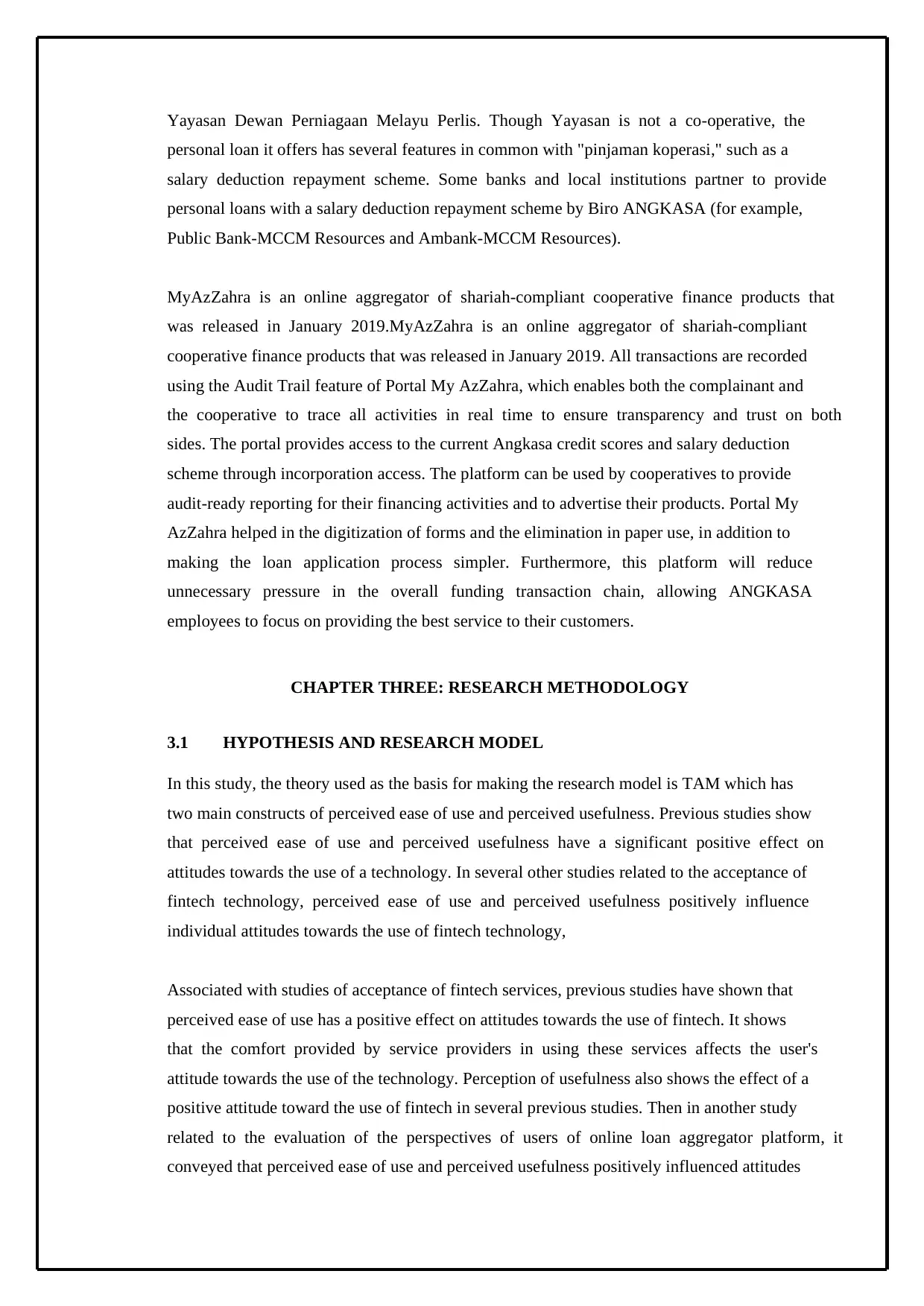
Yayasan Dewan Perniagaan Melayu Perlis. Though Yayasan is not a co-operative, the
personal loan it offers has several features in common with "pinjaman koperasi," such as a
salary deduction repayment scheme. Some banks and local institutions partner to provide
personal loans with a salary deduction repayment scheme by Biro ANGKASA (for example,
Public Bank-MCCM Resources and Ambank-MCCM Resources).
MyAzZahra is an online aggregator of shariah-compliant cooperative finance products that
was released in January 2019.MyAzZahra is an online aggregator of shariah-compliant
cooperative finance products that was released in January 2019. All transactions are recorded
using the Audit Trail feature of Portal My AzZahra, which enables both the complainant and
the cooperative to trace all activities in real time to ensure transparency and trust on both
sides. The portal provides access to the current Angkasa credit scores and salary deduction
scheme through incorporation access. The platform can be used by cooperatives to provide
audit-ready reporting for their financing activities and to advertise their products. Portal My
AzZahra helped in the digitization of forms and the elimination in paper use, in addition to
making the loan application process simpler. Furthermore, this platform will reduce
unnecessary pressure in the overall funding transaction chain, allowing ANGKASA
employees to focus on providing the best service to their customers.
CHAPTER THREE: RESEARCH METHODOLOGY
3.1 HYPOTHESIS AND RESEARCH MODEL
In this study, the theory used as the basis for making the research model is TAM which has
two main constructs of perceived ease of use and perceived usefulness. Previous studies show
that perceived ease of use and perceived usefulness have a significant positive effect on
attitudes towards the use of a technology. In several other studies related to the acceptance of
fintech technology, perceived ease of use and perceived usefulness positively influence
individual attitudes towards the use of fintech technology,
Associated with studies of acceptance of fintech services, previous studies have shown that
perceived ease of use has a positive effect on attitudes towards the use of fintech. It shows
that the comfort provided by service providers in using these services affects the user's
attitude towards the use of the technology. Perception of usefulness also shows the effect of a
positive attitude toward the use of fintech in several previous studies. Then in another study
related to the evaluation of the perspectives of users of online loan aggregator platform, it
conveyed that perceived ease of use and perceived usefulness positively influenced attitudes
personal loan it offers has several features in common with "pinjaman koperasi," such as a
salary deduction repayment scheme. Some banks and local institutions partner to provide
personal loans with a salary deduction repayment scheme by Biro ANGKASA (for example,
Public Bank-MCCM Resources and Ambank-MCCM Resources).
MyAzZahra is an online aggregator of shariah-compliant cooperative finance products that
was released in January 2019.MyAzZahra is an online aggregator of shariah-compliant
cooperative finance products that was released in January 2019. All transactions are recorded
using the Audit Trail feature of Portal My AzZahra, which enables both the complainant and
the cooperative to trace all activities in real time to ensure transparency and trust on both
sides. The portal provides access to the current Angkasa credit scores and salary deduction
scheme through incorporation access. The platform can be used by cooperatives to provide
audit-ready reporting for their financing activities and to advertise their products. Portal My
AzZahra helped in the digitization of forms and the elimination in paper use, in addition to
making the loan application process simpler. Furthermore, this platform will reduce
unnecessary pressure in the overall funding transaction chain, allowing ANGKASA
employees to focus on providing the best service to their customers.
CHAPTER THREE: RESEARCH METHODOLOGY
3.1 HYPOTHESIS AND RESEARCH MODEL
In this study, the theory used as the basis for making the research model is TAM which has
two main constructs of perceived ease of use and perceived usefulness. Previous studies show
that perceived ease of use and perceived usefulness have a significant positive effect on
attitudes towards the use of a technology. In several other studies related to the acceptance of
fintech technology, perceived ease of use and perceived usefulness positively influence
individual attitudes towards the use of fintech technology,
Associated with studies of acceptance of fintech services, previous studies have shown that
perceived ease of use has a positive effect on attitudes towards the use of fintech. It shows
that the comfort provided by service providers in using these services affects the user's
attitude towards the use of the technology. Perception of usefulness also shows the effect of a
positive attitude toward the use of fintech in several previous studies. Then in another study
related to the evaluation of the perspectives of users of online loan aggregator platform, it
conveyed that perceived ease of use and perceived usefulness positively influenced attitudes
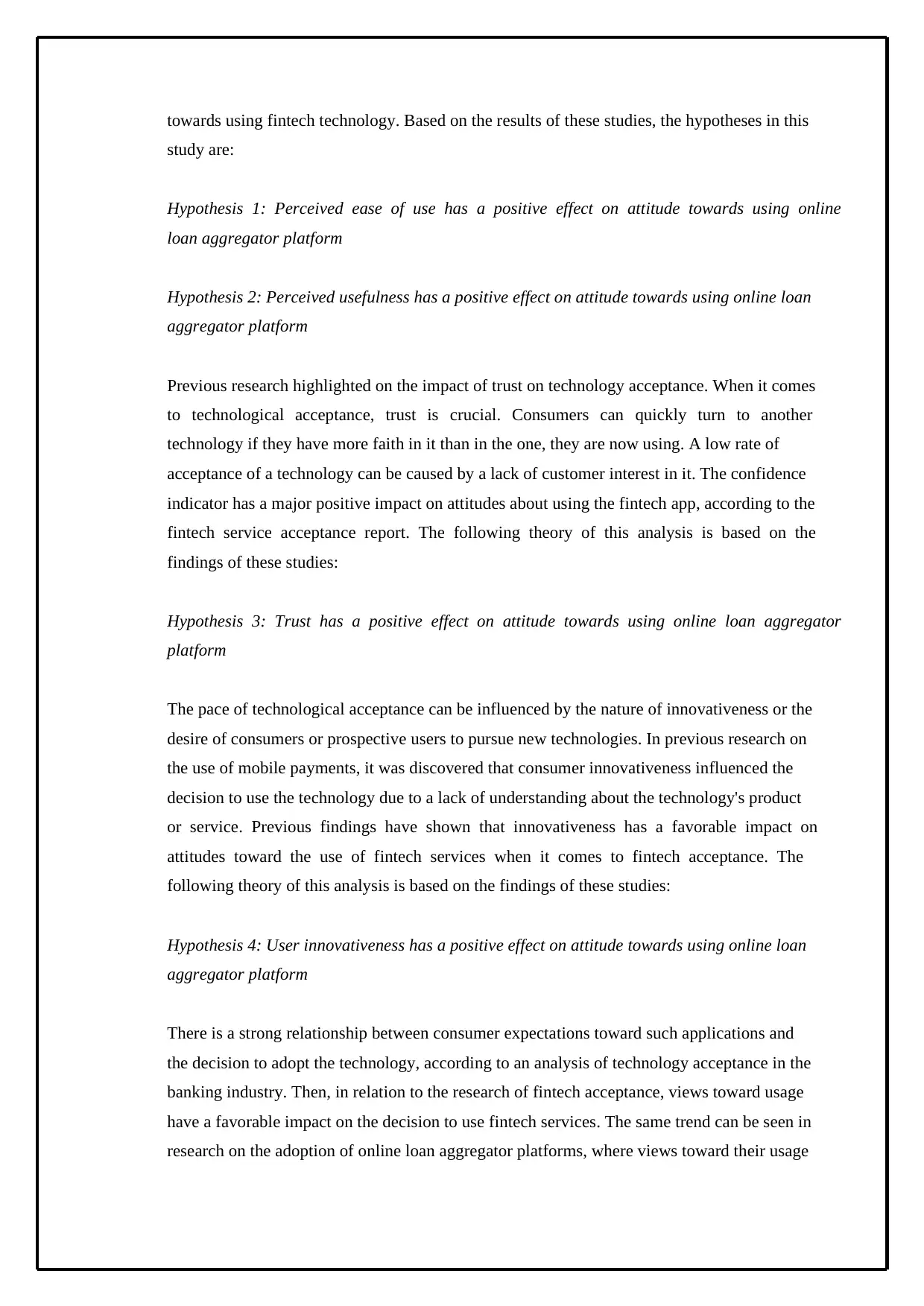
towards using fintech technology. Based on the results of these studies, the hypotheses in this
study are:
Hypothesis 1: Perceived ease of use has a positive effect on attitude towards using online
loan aggregator platform
Hypothesis 2: Perceived usefulness has a positive effect on attitude towards using online loan
aggregator platform
Previous research highlighted on the impact of trust on technology acceptance. When it comes
to technological acceptance, trust is crucial. Consumers can quickly turn to another
technology if they have more faith in it than in the one, they are now using. A low rate of
acceptance of a technology can be caused by a lack of customer interest in it. The confidence
indicator has a major positive impact on attitudes about using the fintech app, according to the
fintech service acceptance report. The following theory of this analysis is based on the
findings of these studies:
Hypothesis 3: Trust has a positive effect on attitude towards using online loan aggregator
platform
The pace of technological acceptance can be influenced by the nature of innovativeness or the
desire of consumers or prospective users to pursue new technologies. In previous research on
the use of mobile payments, it was discovered that consumer innovativeness influenced the
decision to use the technology due to a lack of understanding about the technology's product
or service. Previous findings have shown that innovativeness has a favorable impact on
attitudes toward the use of fintech services when it comes to fintech acceptance. The
following theory of this analysis is based on the findings of these studies:
Hypothesis 4: User innovativeness has a positive effect on attitude towards using online loan
aggregator platform
There is a strong relationship between consumer expectations toward such applications and
the decision to adopt the technology, according to an analysis of technology acceptance in the
banking industry. Then, in relation to the research of fintech acceptance, views toward usage
have a favorable impact on the decision to use fintech services. The same trend can be seen in
research on the adoption of online loan aggregator platforms, where views toward their usage
study are:
Hypothesis 1: Perceived ease of use has a positive effect on attitude towards using online
loan aggregator platform
Hypothesis 2: Perceived usefulness has a positive effect on attitude towards using online loan
aggregator platform
Previous research highlighted on the impact of trust on technology acceptance. When it comes
to technological acceptance, trust is crucial. Consumers can quickly turn to another
technology if they have more faith in it than in the one, they are now using. A low rate of
acceptance of a technology can be caused by a lack of customer interest in it. The confidence
indicator has a major positive impact on attitudes about using the fintech app, according to the
fintech service acceptance report. The following theory of this analysis is based on the
findings of these studies:
Hypothesis 3: Trust has a positive effect on attitude towards using online loan aggregator
platform
The pace of technological acceptance can be influenced by the nature of innovativeness or the
desire of consumers or prospective users to pursue new technologies. In previous research on
the use of mobile payments, it was discovered that consumer innovativeness influenced the
decision to use the technology due to a lack of understanding about the technology's product
or service. Previous findings have shown that innovativeness has a favorable impact on
attitudes toward the use of fintech services when it comes to fintech acceptance. The
following theory of this analysis is based on the findings of these studies:
Hypothesis 4: User innovativeness has a positive effect on attitude towards using online loan
aggregator platform
There is a strong relationship between consumer expectations toward such applications and
the decision to adopt the technology, according to an analysis of technology acceptance in the
banking industry. Then, in relation to the research of fintech acceptance, views toward usage
have a favorable impact on the decision to use fintech services. The same trend can be seen in
research on the adoption of online loan aggregator platforms, where views toward their usage
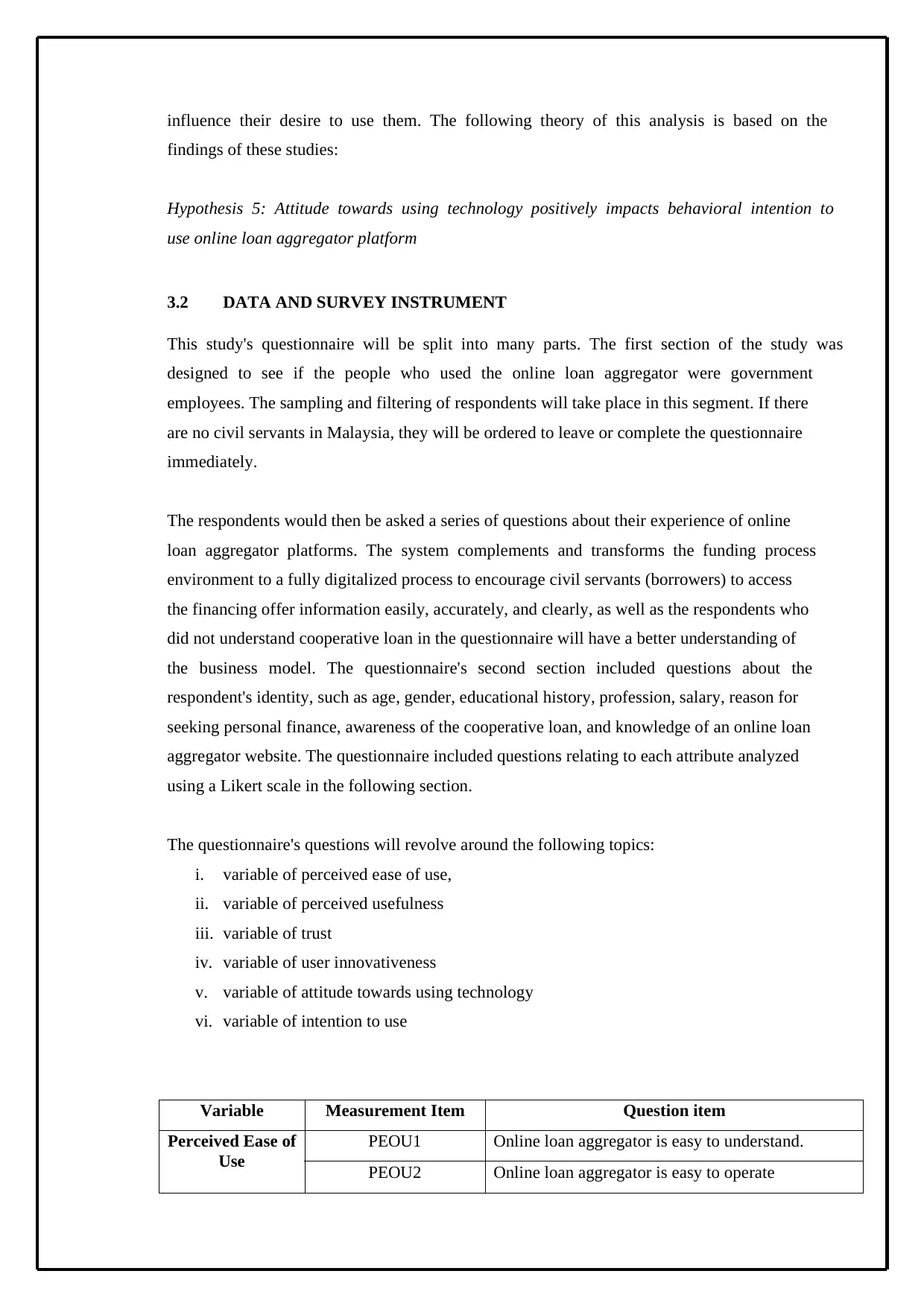
influence their desire to use them. The following theory of this analysis is based on the
findings of these studies:
Hypothesis 5: Attitude towards using technology positively impacts behavioral intention to
use online loan aggregator platform
3.2 DATA AND SURVEY INSTRUMENT
This study's questionnaire will be split into many parts. The first section of the study was
designed to see if the people who used the online loan aggregator were government
employees. The sampling and filtering of respondents will take place in this segment. If there
are no civil servants in Malaysia, they will be ordered to leave or complete the questionnaire
immediately.
The respondents would then be asked a series of questions about their experience of online
loan aggregator platforms. The system complements and transforms the funding process
environment to a fully digitalized process to encourage civil servants (borrowers) to access
the financing offer information easily, accurately, and clearly, as well as the respondents who
did not understand cooperative loan in the questionnaire will have a better understanding of
the business model. The questionnaire's second section included questions about the
respondent's identity, such as age, gender, educational history, profession, salary, reason for
seeking personal finance, awareness of the cooperative loan, and knowledge of an online loan
aggregator website. The questionnaire included questions relating to each attribute analyzed
using a Likert scale in the following section.
The questionnaire's questions will revolve around the following topics:
i. variable of perceived ease of use,
ii. variable of perceived usefulness
iii. variable of trust
iv. variable of user innovativeness
v. variable of attitude towards using technology
vi. variable of intention to use
Variable Measurement Item Question item
Perceived Ease of
Use
PEOU1 Online loan aggregator is easy to understand.
PEOU2 Online loan aggregator is easy to operate
findings of these studies:
Hypothesis 5: Attitude towards using technology positively impacts behavioral intention to
use online loan aggregator platform
3.2 DATA AND SURVEY INSTRUMENT
This study's questionnaire will be split into many parts. The first section of the study was
designed to see if the people who used the online loan aggregator were government
employees. The sampling and filtering of respondents will take place in this segment. If there
are no civil servants in Malaysia, they will be ordered to leave or complete the questionnaire
immediately.
The respondents would then be asked a series of questions about their experience of online
loan aggregator platforms. The system complements and transforms the funding process
environment to a fully digitalized process to encourage civil servants (borrowers) to access
the financing offer information easily, accurately, and clearly, as well as the respondents who
did not understand cooperative loan in the questionnaire will have a better understanding of
the business model. The questionnaire's second section included questions about the
respondent's identity, such as age, gender, educational history, profession, salary, reason for
seeking personal finance, awareness of the cooperative loan, and knowledge of an online loan
aggregator website. The questionnaire included questions relating to each attribute analyzed
using a Likert scale in the following section.
The questionnaire's questions will revolve around the following topics:
i. variable of perceived ease of use,
ii. variable of perceived usefulness
iii. variable of trust
iv. variable of user innovativeness
v. variable of attitude towards using technology
vi. variable of intention to use
Variable Measurement Item Question item
Perceived Ease of
Use
PEOU1 Online loan aggregator is easy to understand.
PEOU2 Online loan aggregator is easy to operate
Secure Best Marks with AI Grader
Need help grading? Try our AI Grader for instant feedback on your assignments.
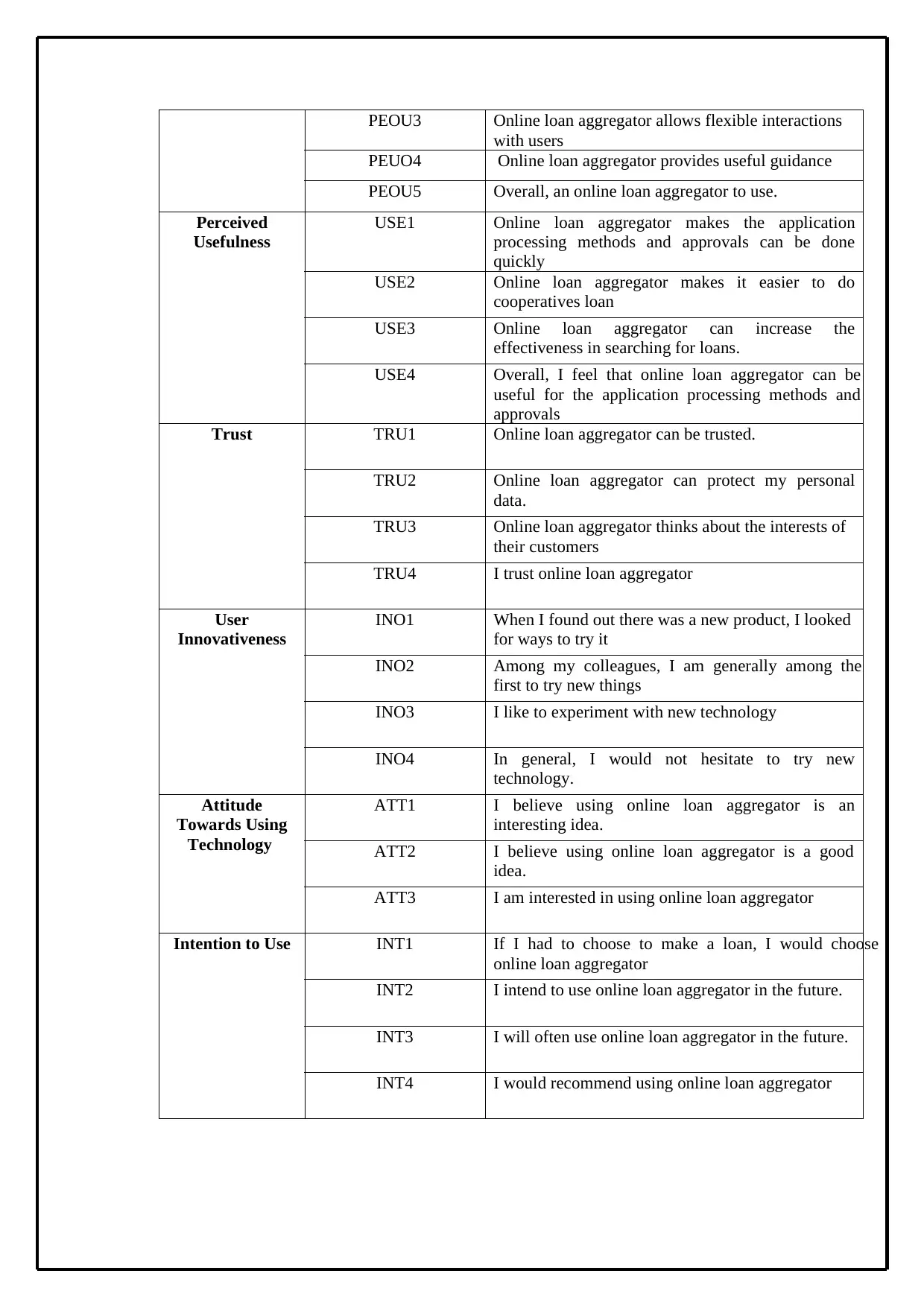
PEOU3 Online loan aggregator allows flexible interactions
with users
PEUO4 Online loan aggregator provides useful guidance
PEOU5 Overall, an online loan aggregator to use.
Perceived
Usefulness
USE1 Online loan aggregator makes the application
processing methods and approvals can be done
quickly
USE2 Online loan aggregator makes it easier to do
cooperatives loan
USE3 Online loan aggregator can increase the
effectiveness in searching for loans.
USE4 Overall, I feel that online loan aggregator can be
useful for the application processing methods and
approvals
Trust TRU1 Online loan aggregator can be trusted.
TRU2 Online loan aggregator can protect my personal
data.
TRU3 Online loan aggregator thinks about the interests of
their customers
TRU4 I trust online loan aggregator
User
Innovativeness
INO1 When I found out there was a new product, I looked
for ways to try it
INO2 Among my colleagues, I am generally among the
first to try new things
INO3 I like to experiment with new technology
INO4 In general, I would not hesitate to try new
technology.
Attitude
Towards Using
Technology
ATT1 I believe using online loan aggregator is an
interesting idea.
ATT2 I believe using online loan aggregator is a good
idea.
ATT3 I am interested in using online loan aggregator
Intention to Use INT1 If I had to choose to make a loan, I would choose
online loan aggregator
INT2 I intend to use online loan aggregator in the future.
INT3 I will often use online loan aggregator in the future.
INT4 I would recommend using online loan aggregator
with users
PEUO4 Online loan aggregator provides useful guidance
PEOU5 Overall, an online loan aggregator to use.
Perceived
Usefulness
USE1 Online loan aggregator makes the application
processing methods and approvals can be done
quickly
USE2 Online loan aggregator makes it easier to do
cooperatives loan
USE3 Online loan aggregator can increase the
effectiveness in searching for loans.
USE4 Overall, I feel that online loan aggregator can be
useful for the application processing methods and
approvals
Trust TRU1 Online loan aggregator can be trusted.
TRU2 Online loan aggregator can protect my personal
data.
TRU3 Online loan aggregator thinks about the interests of
their customers
TRU4 I trust online loan aggregator
User
Innovativeness
INO1 When I found out there was a new product, I looked
for ways to try it
INO2 Among my colleagues, I am generally among the
first to try new things
INO3 I like to experiment with new technology
INO4 In general, I would not hesitate to try new
technology.
Attitude
Towards Using
Technology
ATT1 I believe using online loan aggregator is an
interesting idea.
ATT2 I believe using online loan aggregator is a good
idea.
ATT3 I am interested in using online loan aggregator
Intention to Use INT1 If I had to choose to make a loan, I would choose
online loan aggregator
INT2 I intend to use online loan aggregator in the future.
INT3 I will often use online loan aggregator in the future.
INT4 I would recommend using online loan aggregator
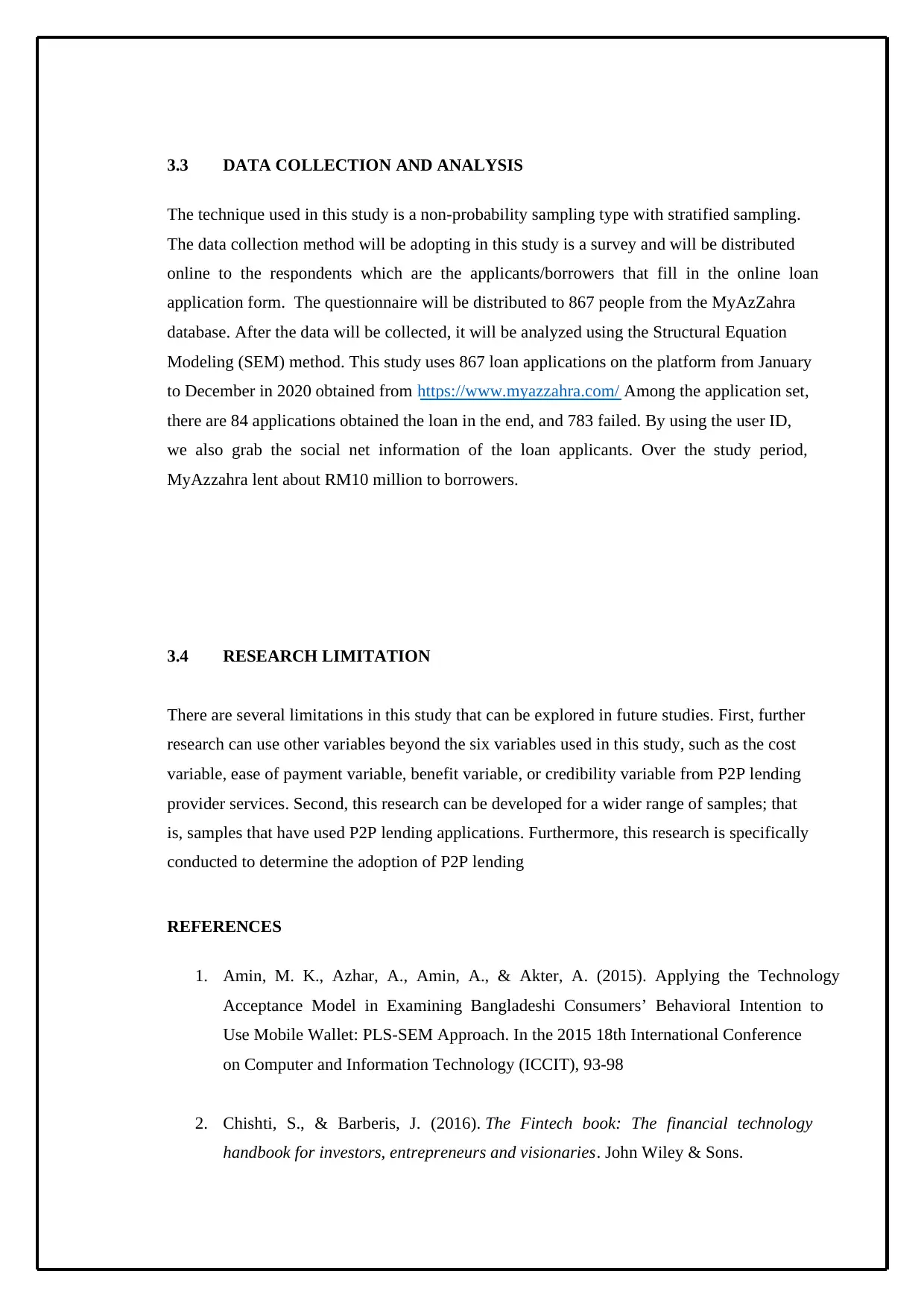
3.3 DATA COLLECTION AND ANALYSIS
The technique used in this study is a non-probability sampling type with stratified sampling.
The data collection method will be adopting in this study is a survey and will be distributed
online to the respondents which are the applicants/borrowers that fill in the online loan
application form. The questionnaire will be distributed to 867 people from the MyAzZahra
database. After the data will be collected, it will be analyzed using the Structural Equation
Modeling (SEM) method. This study uses 867 loan applications on the platform from January
to December in 2020 obtained from https://www.myazzahra.com/ Among the application set,
there are 84 applications obtained the loan in the end, and 783 failed. By using the user ID,
we also grab the social net information of the loan applicants. Over the study period,
MyAzzahra lent about RM10 million to borrowers.
3.4 RESEARCH LIMITATION
There are several limitations in this study that can be explored in future studies. First, further
research can use other variables beyond the six variables used in this study, such as the cost
variable, ease of payment variable, benefit variable, or credibility variable from P2P lending
provider services. Second, this research can be developed for a wider range of samples; that
is, samples that have used P2P lending applications. Furthermore, this research is specifically
conducted to determine the adoption of P2P lending
REFERENCES
1. Amin, M. K., Azhar, A., Amin, A., & Akter, A. (2015). Applying the Technology
Acceptance Model in Examining Bangladeshi Consumers’ Behavioral Intention to
Use Mobile Wallet: PLS-SEM Approach. In the 2015 18th International Conference
on Computer and Information Technology (ICCIT), 93-98
2. Chishti, S., & Barberis, J. (2016). The Fintech book: The financial technology
handbook for investors, entrepreneurs and visionaries. John Wiley & Sons.
The technique used in this study is a non-probability sampling type with stratified sampling.
The data collection method will be adopting in this study is a survey and will be distributed
online to the respondents which are the applicants/borrowers that fill in the online loan
application form. The questionnaire will be distributed to 867 people from the MyAzZahra
database. After the data will be collected, it will be analyzed using the Structural Equation
Modeling (SEM) method. This study uses 867 loan applications on the platform from January
to December in 2020 obtained from https://www.myazzahra.com/ Among the application set,
there are 84 applications obtained the loan in the end, and 783 failed. By using the user ID,
we also grab the social net information of the loan applicants. Over the study period,
MyAzzahra lent about RM10 million to borrowers.
3.4 RESEARCH LIMITATION
There are several limitations in this study that can be explored in future studies. First, further
research can use other variables beyond the six variables used in this study, such as the cost
variable, ease of payment variable, benefit variable, or credibility variable from P2P lending
provider services. Second, this research can be developed for a wider range of samples; that
is, samples that have used P2P lending applications. Furthermore, this research is specifically
conducted to determine the adoption of P2P lending
REFERENCES
1. Amin, M. K., Azhar, A., Amin, A., & Akter, A. (2015). Applying the Technology
Acceptance Model in Examining Bangladeshi Consumers’ Behavioral Intention to
Use Mobile Wallet: PLS-SEM Approach. In the 2015 18th International Conference
on Computer and Information Technology (ICCIT), 93-98
2. Chishti, S., & Barberis, J. (2016). The Fintech book: The financial technology
handbook for investors, entrepreneurs and visionaries. John Wiley & Sons.
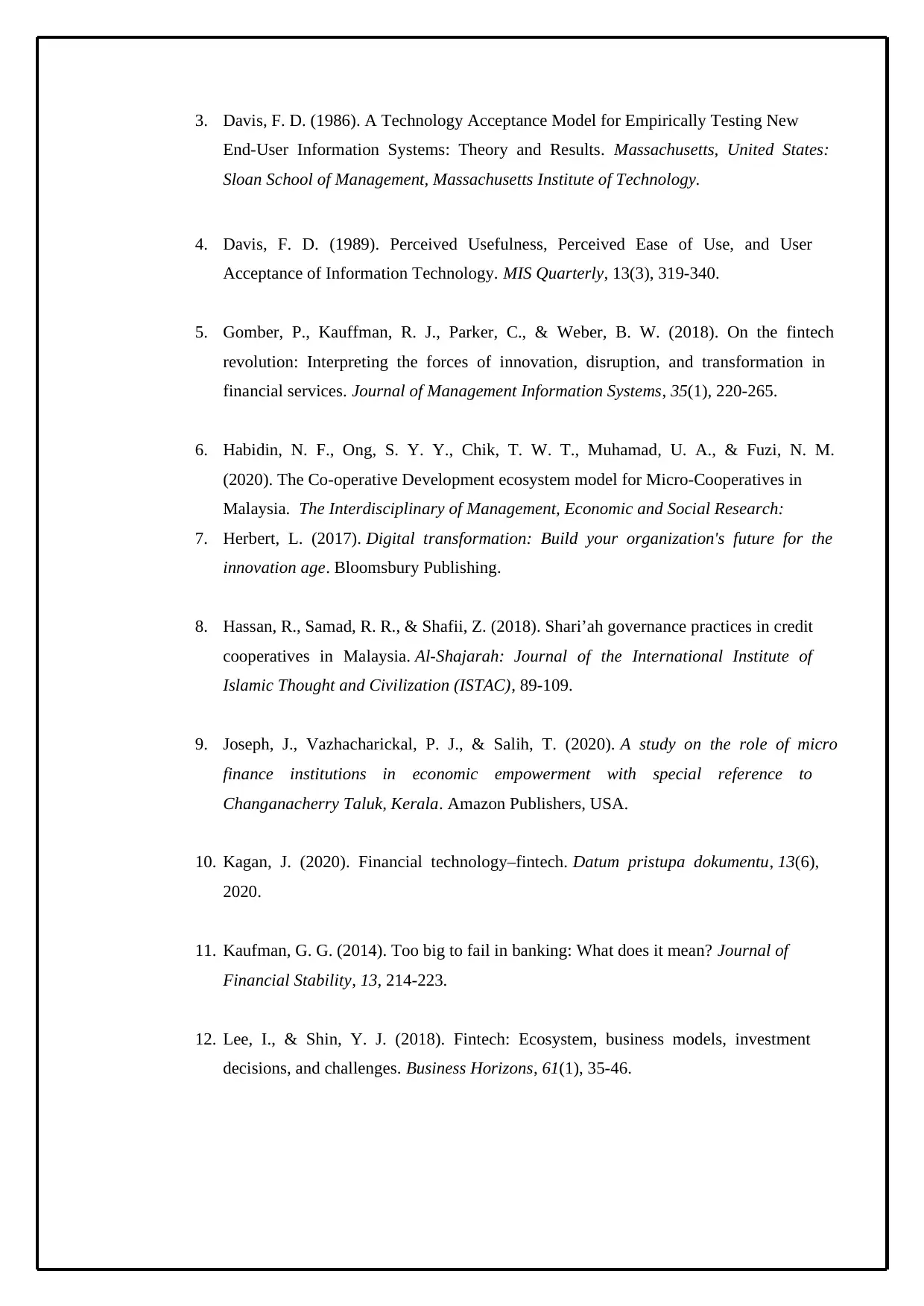
3. Davis, F. D. (1986). A Technology Acceptance Model for Empirically Testing New
End-User Information Systems: Theory and Results. Massachusetts, United States:
Sloan School of Management, Massachusetts Institute of Technology.
4. Davis, F. D. (1989). Perceived Usefulness, Perceived Ease of Use, and User
Acceptance of Information Technology. MIS Quarterly, 13(3), 319-340.
5. Gomber, P., Kauffman, R. J., Parker, C., & Weber, B. W. (2018). On the fintech
revolution: Interpreting the forces of innovation, disruption, and transformation in
financial services. Journal of Management Information Systems, 35(1), 220-265.
6. Habidin, N. F., Ong, S. Y. Y., Chik, T. W. T., Muhamad, U. A., & Fuzi, N. M.
(2020). The Co-operative Development ecosystem model for Micro-Cooperatives in
Malaysia. The Interdisciplinary of Management, Economic and Social Research:
7. Herbert, L. (2017). Digital transformation: Build your organization's future for the
innovation age. Bloomsbury Publishing.
8. Hassan, R., Samad, R. R., & Shafii, Z. (2018). Shari’ah governance practices in credit
cooperatives in Malaysia. Al-Shajarah: Journal of the International Institute of
Islamic Thought and Civilization (ISTAC), 89-109.
9. Joseph, J., Vazhacharickal, P. J., & Salih, T. (2020). A study on the role of micro
finance institutions in economic empowerment with special reference to
Changanacherry Taluk, Kerala. Amazon Publishers, USA.
10. Kagan, J. (2020). Financial technology–fintech. Datum pristupa dokumentu, 13(6),
2020.
11. Kaufman, G. G. (2014). Too big to fail in banking: What does it mean? Journal of
Financial Stability, 13, 214-223.
12. Lee, I., & Shin, Y. J. (2018). Fintech: Ecosystem, business models, investment
decisions, and challenges. Business Horizons, 61(1), 35-46.
End-User Information Systems: Theory and Results. Massachusetts, United States:
Sloan School of Management, Massachusetts Institute of Technology.
4. Davis, F. D. (1989). Perceived Usefulness, Perceived Ease of Use, and User
Acceptance of Information Technology. MIS Quarterly, 13(3), 319-340.
5. Gomber, P., Kauffman, R. J., Parker, C., & Weber, B. W. (2018). On the fintech
revolution: Interpreting the forces of innovation, disruption, and transformation in
financial services. Journal of Management Information Systems, 35(1), 220-265.
6. Habidin, N. F., Ong, S. Y. Y., Chik, T. W. T., Muhamad, U. A., & Fuzi, N. M.
(2020). The Co-operative Development ecosystem model for Micro-Cooperatives in
Malaysia. The Interdisciplinary of Management, Economic and Social Research:
7. Herbert, L. (2017). Digital transformation: Build your organization's future for the
innovation age. Bloomsbury Publishing.
8. Hassan, R., Samad, R. R., & Shafii, Z. (2018). Shari’ah governance practices in credit
cooperatives in Malaysia. Al-Shajarah: Journal of the International Institute of
Islamic Thought and Civilization (ISTAC), 89-109.
9. Joseph, J., Vazhacharickal, P. J., & Salih, T. (2020). A study on the role of micro
finance institutions in economic empowerment with special reference to
Changanacherry Taluk, Kerala. Amazon Publishers, USA.
10. Kagan, J. (2020). Financial technology–fintech. Datum pristupa dokumentu, 13(6),
2020.
11. Kaufman, G. G. (2014). Too big to fail in banking: What does it mean? Journal of
Financial Stability, 13, 214-223.
12. Lee, I., & Shin, Y. J. (2018). Fintech: Ecosystem, business models, investment
decisions, and challenges. Business Horizons, 61(1), 35-46.
Paraphrase This Document
Need a fresh take? Get an instant paraphrase of this document with our AI Paraphraser
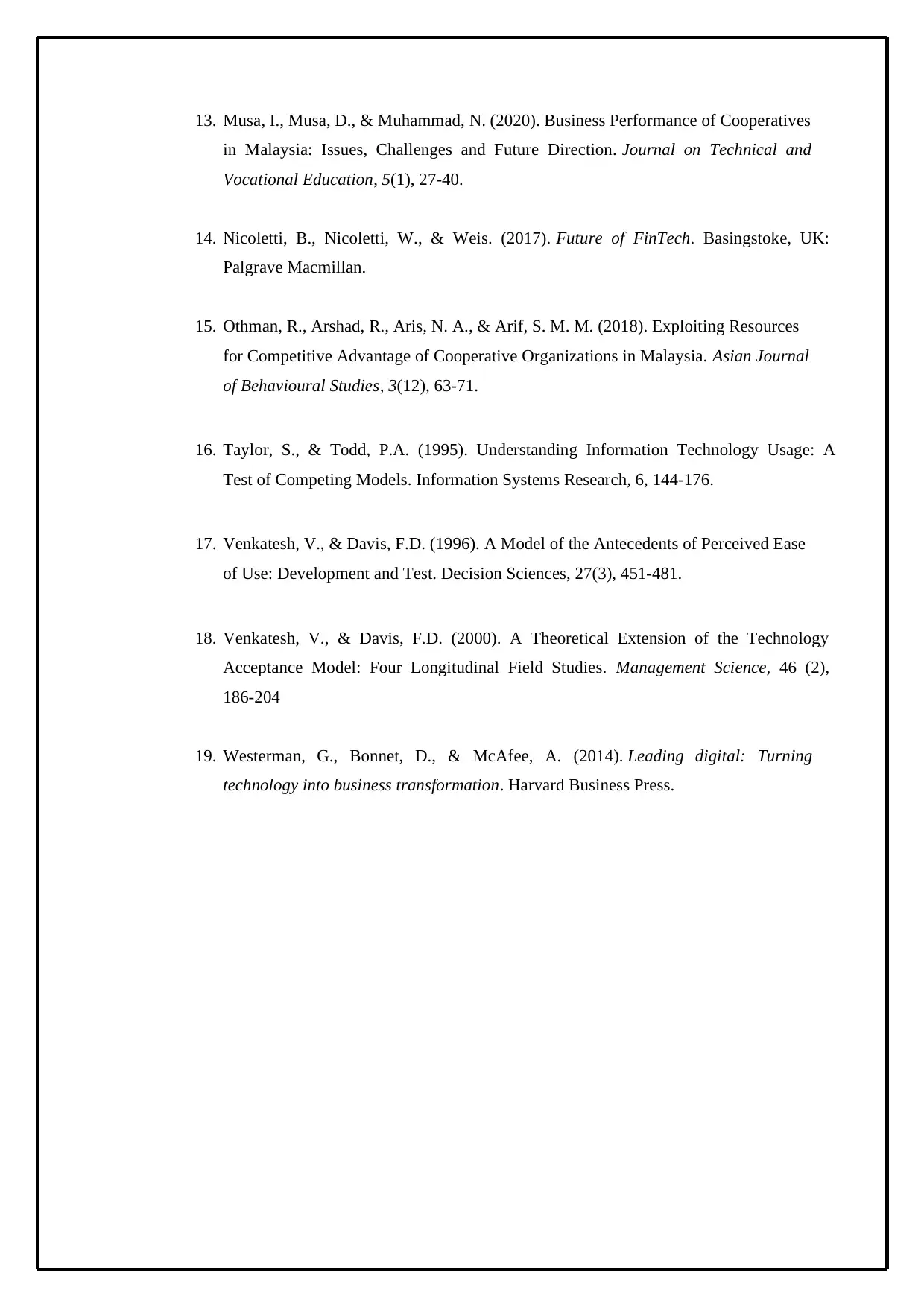
13. Musa, I., Musa, D., & Muhammad, N. (2020). Business Performance of Cooperatives
in Malaysia: Issues, Challenges and Future Direction. Journal on Technical and
Vocational Education, 5(1), 27-40.
14. Nicoletti, B., Nicoletti, W., & Weis. (2017). Future of FinTech. Basingstoke, UK:
Palgrave Macmillan.
15. Othman, R., Arshad, R., Aris, N. A., & Arif, S. M. M. (2018). Exploiting Resources
for Competitive Advantage of Cooperative Organizations in Malaysia. Asian Journal
of Behavioural Studies, 3(12), 63-71.
16. Taylor, S., & Todd, P.A. (1995). Understanding Information Technology Usage: A
Test of Competing Models. Information Systems Research, 6, 144-176.
17. Venkatesh, V., & Davis, F.D. (1996). A Model of the Antecedents of Perceived Ease
of Use: Development and Test. Decision Sciences, 27(3), 451-481.
18. Venkatesh, V., & Davis, F.D. (2000). A Theoretical Extension of the Technology
Acceptance Model: Four Longitudinal Field Studies. Management Science, 46 (2),
186-204
19. Westerman, G., Bonnet, D., & McAfee, A. (2014). Leading digital: Turning
technology into business transformation. Harvard Business Press.
in Malaysia: Issues, Challenges and Future Direction. Journal on Technical and
Vocational Education, 5(1), 27-40.
14. Nicoletti, B., Nicoletti, W., & Weis. (2017). Future of FinTech. Basingstoke, UK:
Palgrave Macmillan.
15. Othman, R., Arshad, R., Aris, N. A., & Arif, S. M. M. (2018). Exploiting Resources
for Competitive Advantage of Cooperative Organizations in Malaysia. Asian Journal
of Behavioural Studies, 3(12), 63-71.
16. Taylor, S., & Todd, P.A. (1995). Understanding Information Technology Usage: A
Test of Competing Models. Information Systems Research, 6, 144-176.
17. Venkatesh, V., & Davis, F.D. (1996). A Model of the Antecedents of Perceived Ease
of Use: Development and Test. Decision Sciences, 27(3), 451-481.
18. Venkatesh, V., & Davis, F.D. (2000). A Theoretical Extension of the Technology
Acceptance Model: Four Longitudinal Field Studies. Management Science, 46 (2),
186-204
19. Westerman, G., Bonnet, D., & McAfee, A. (2014). Leading digital: Turning
technology into business transformation. Harvard Business Press.
1 out of 20
Your All-in-One AI-Powered Toolkit for Academic Success.
+13062052269
info@desklib.com
Available 24*7 on WhatsApp / Email
![[object Object]](/_next/static/media/star-bottom.7253800d.svg)
Unlock your academic potential
© 2024 | Zucol Services PVT LTD | All rights reserved.